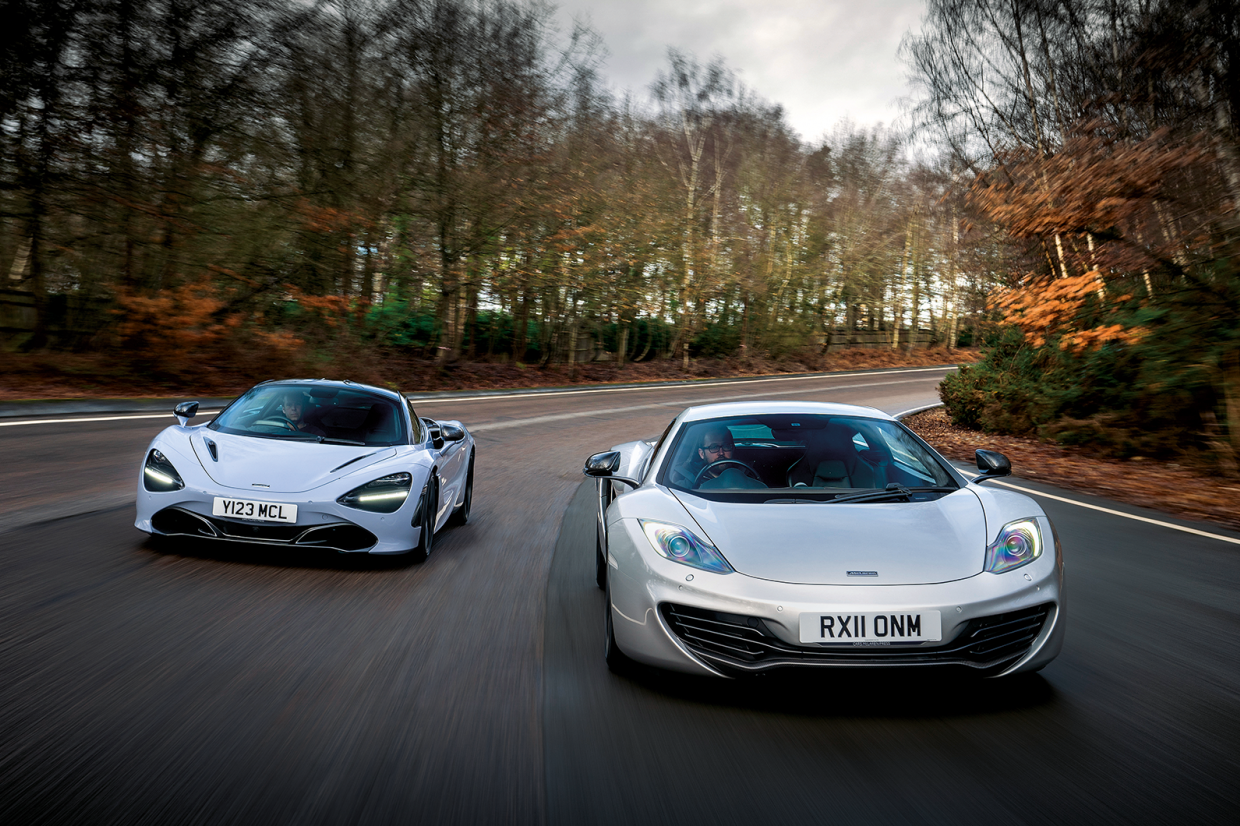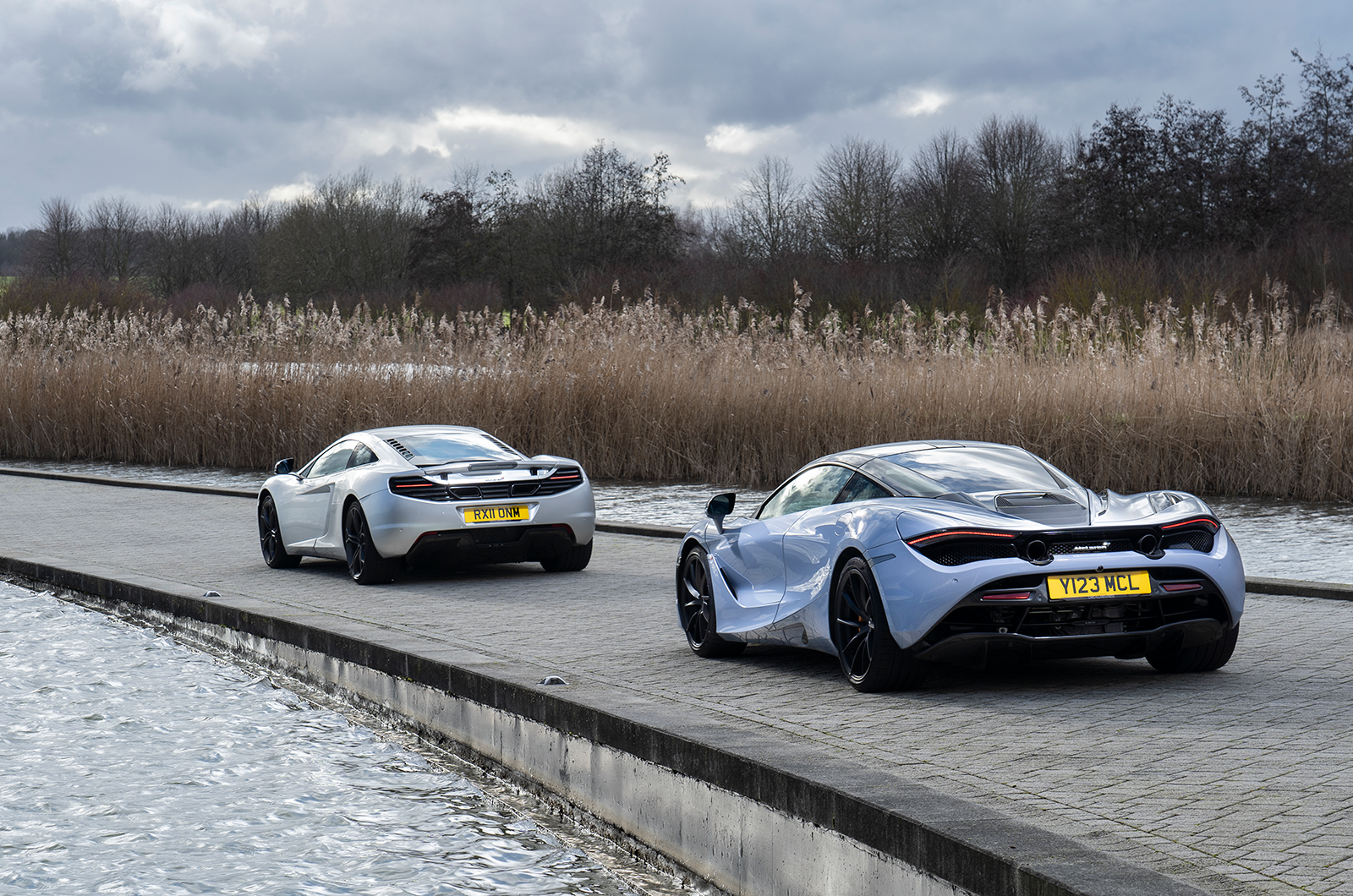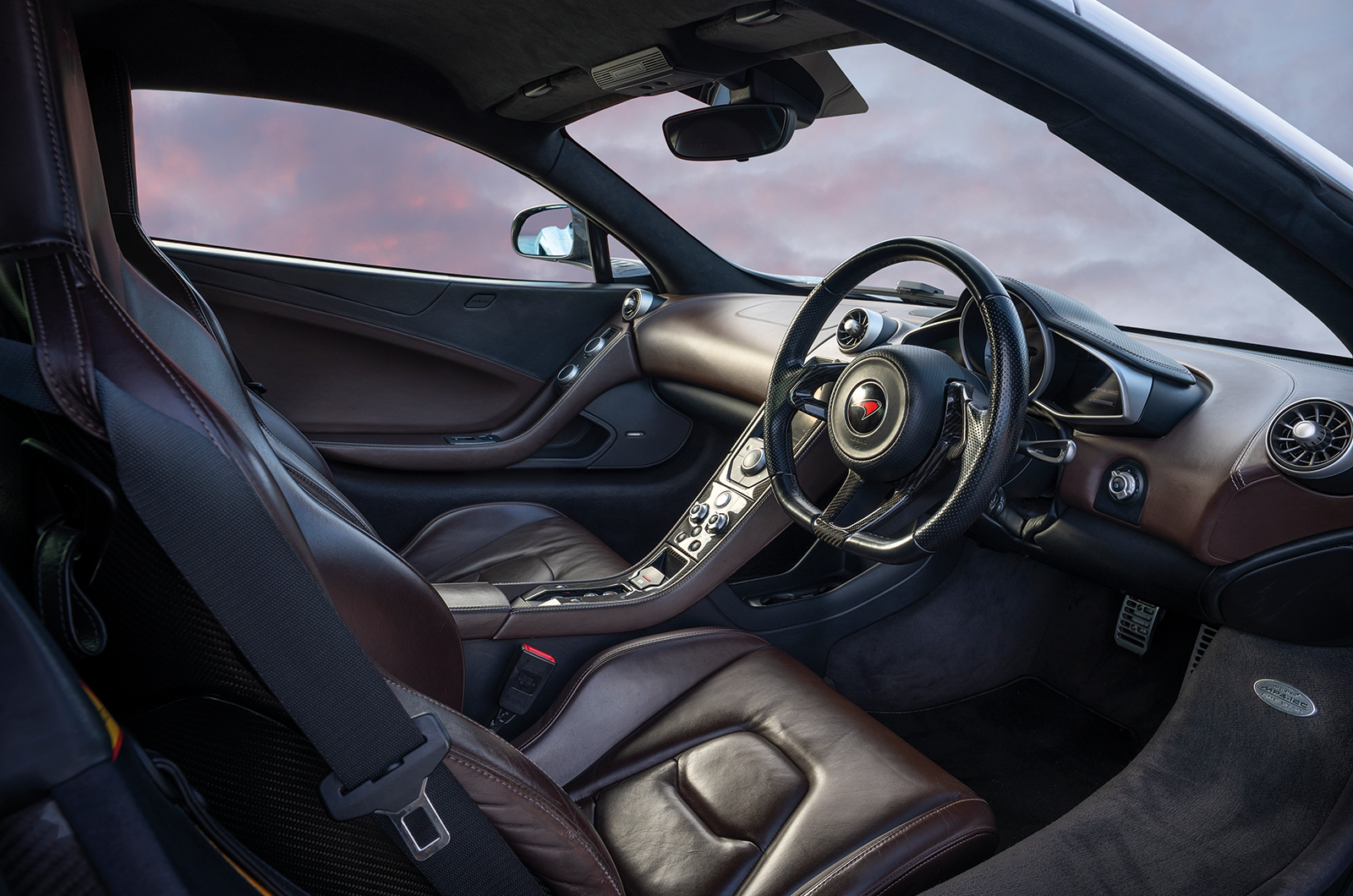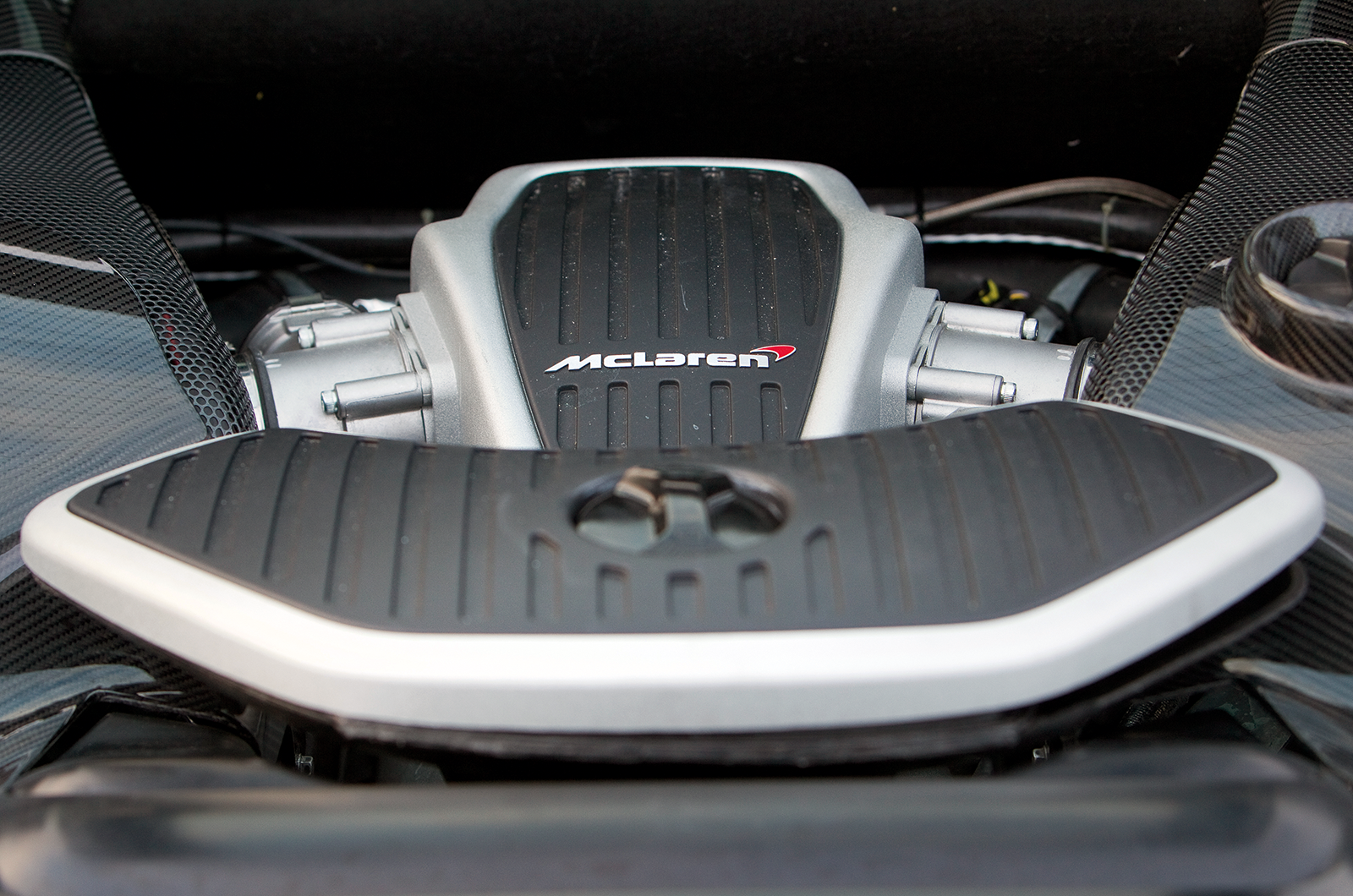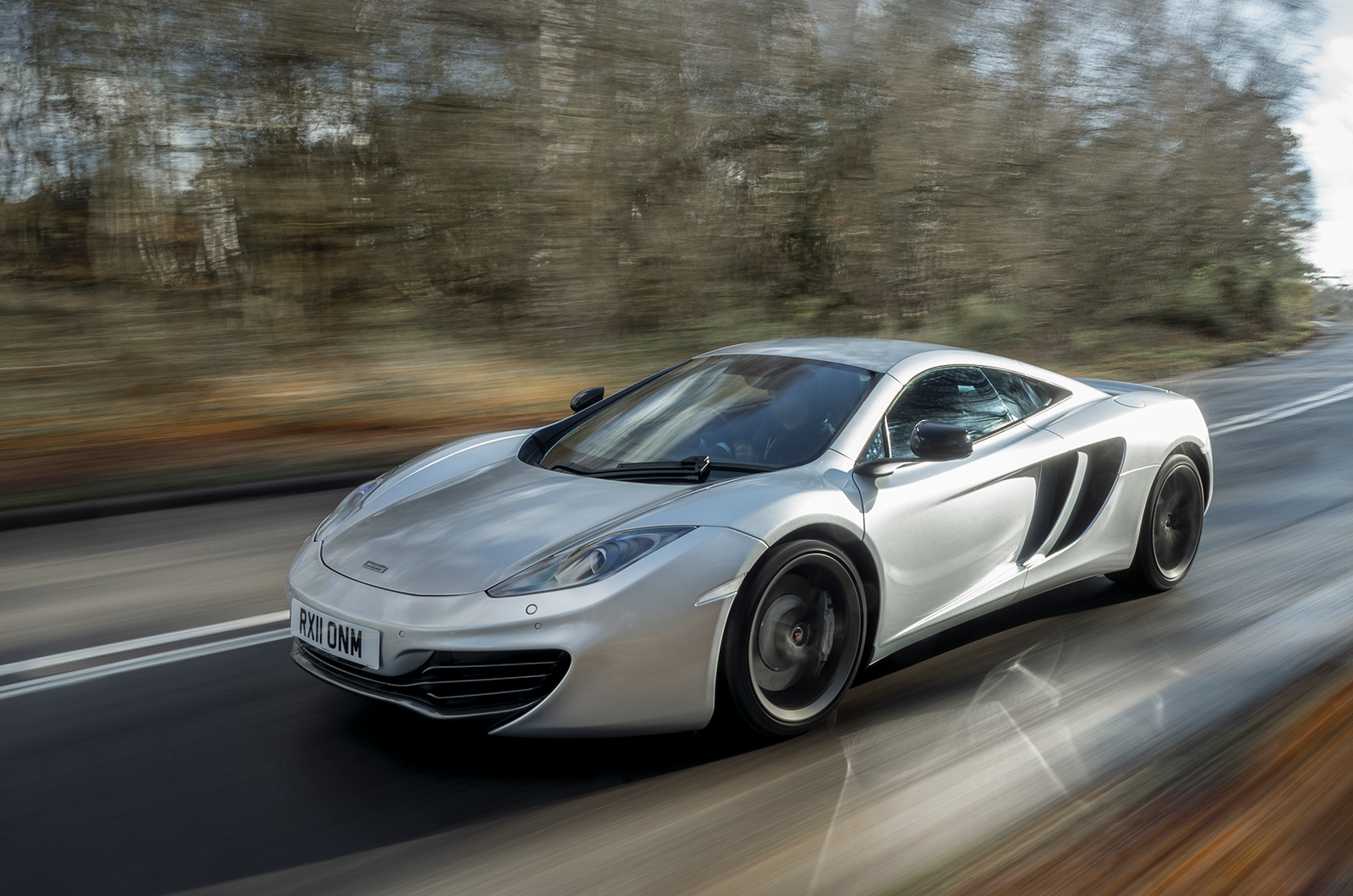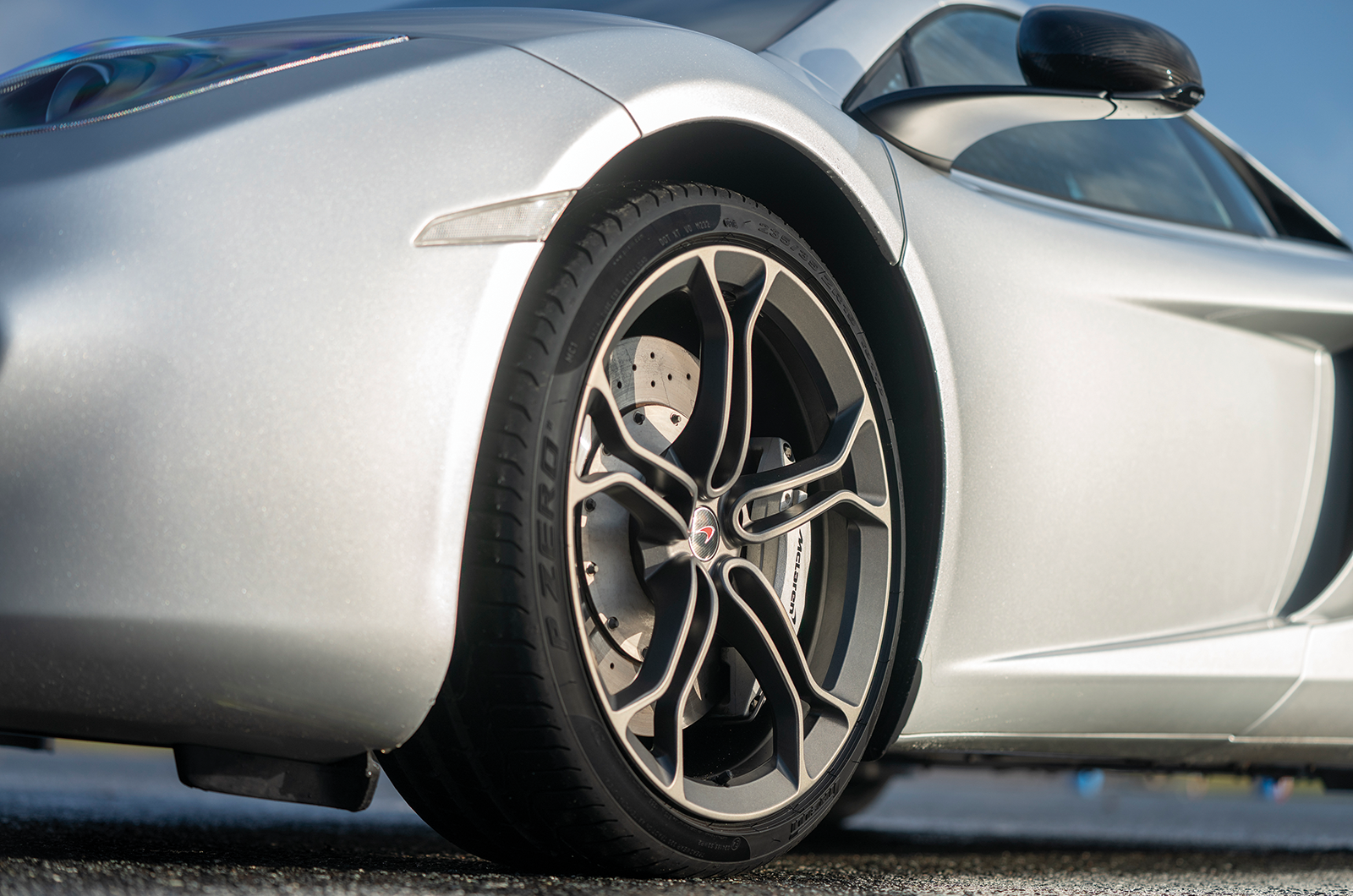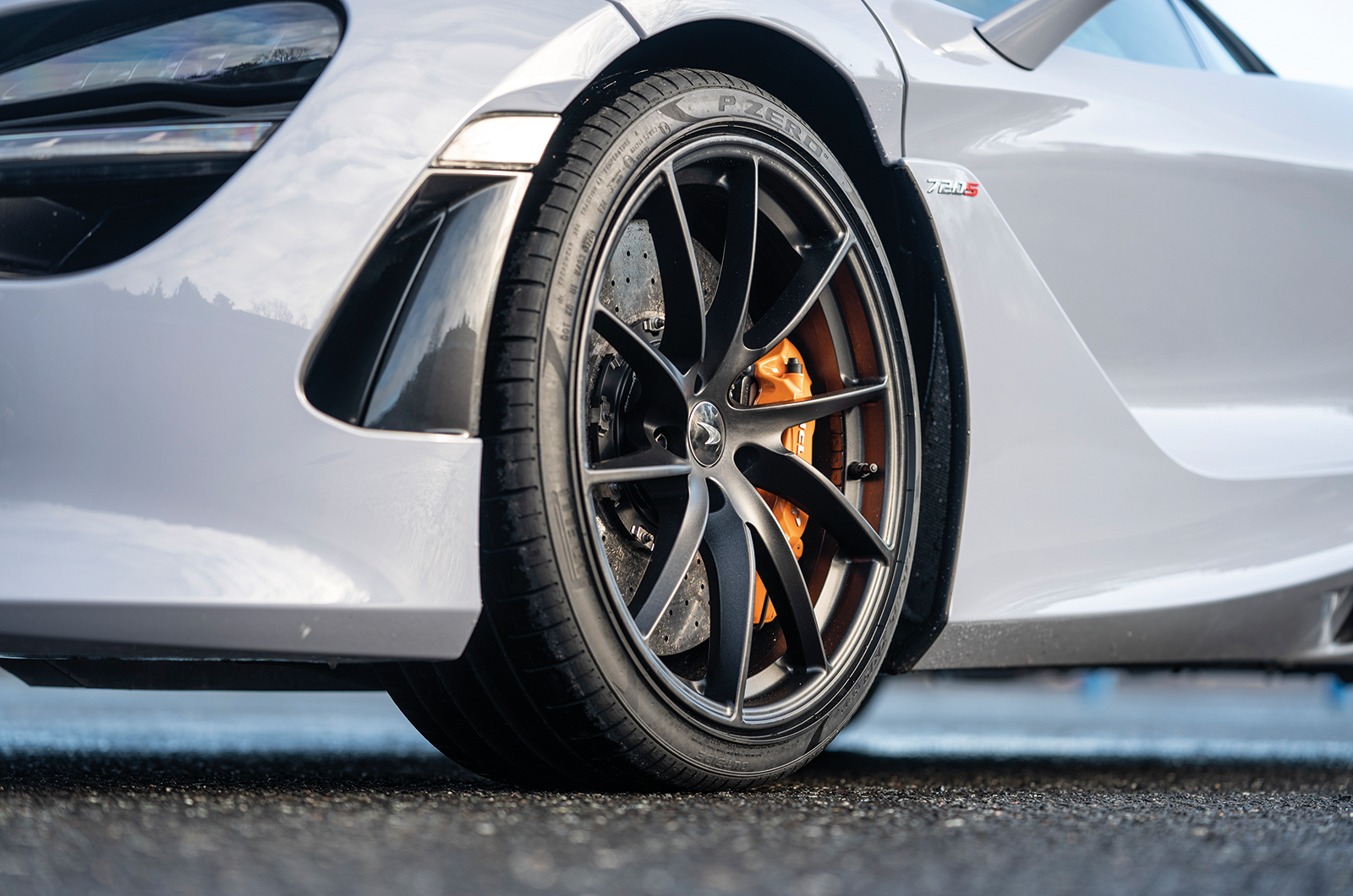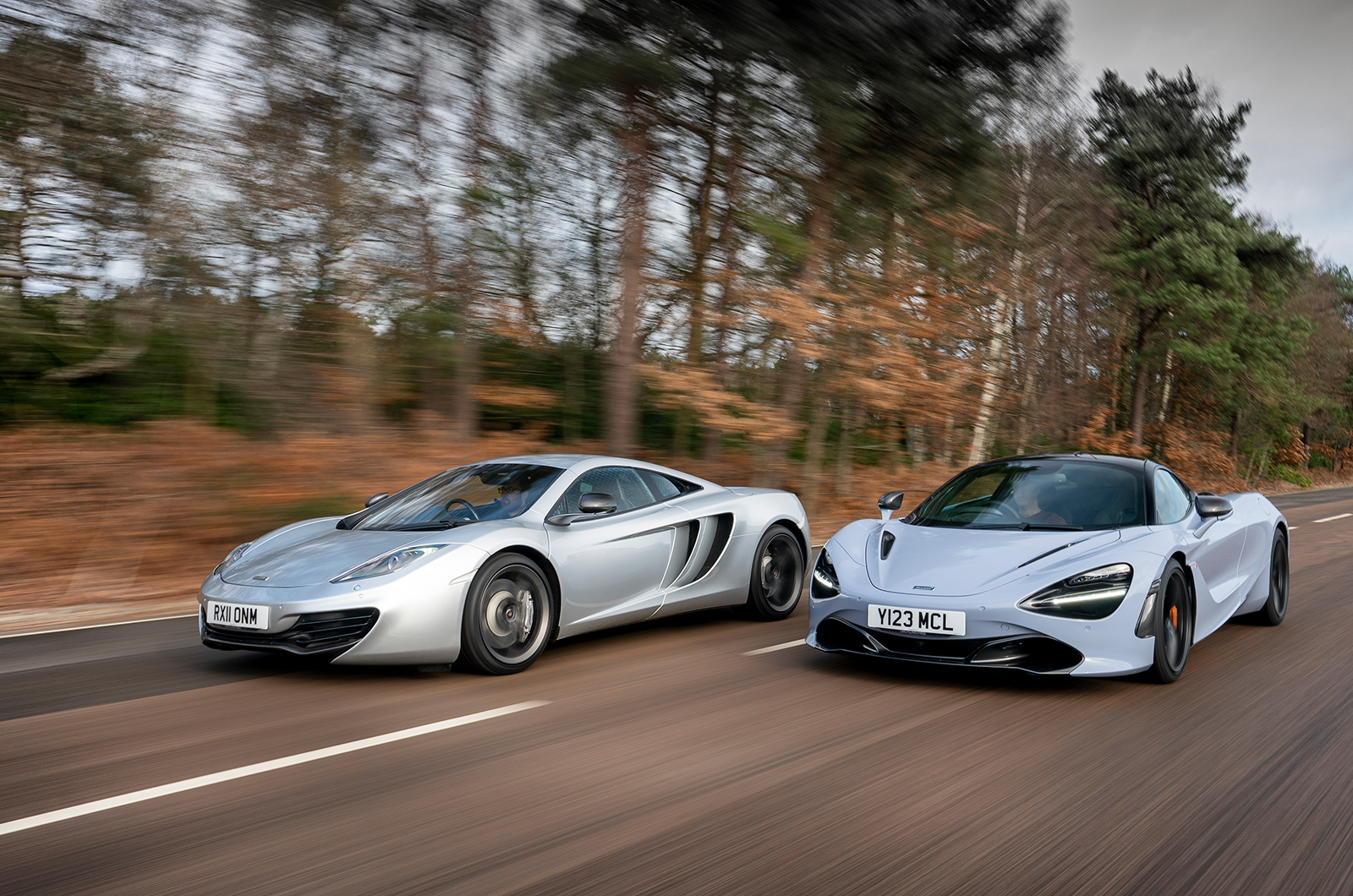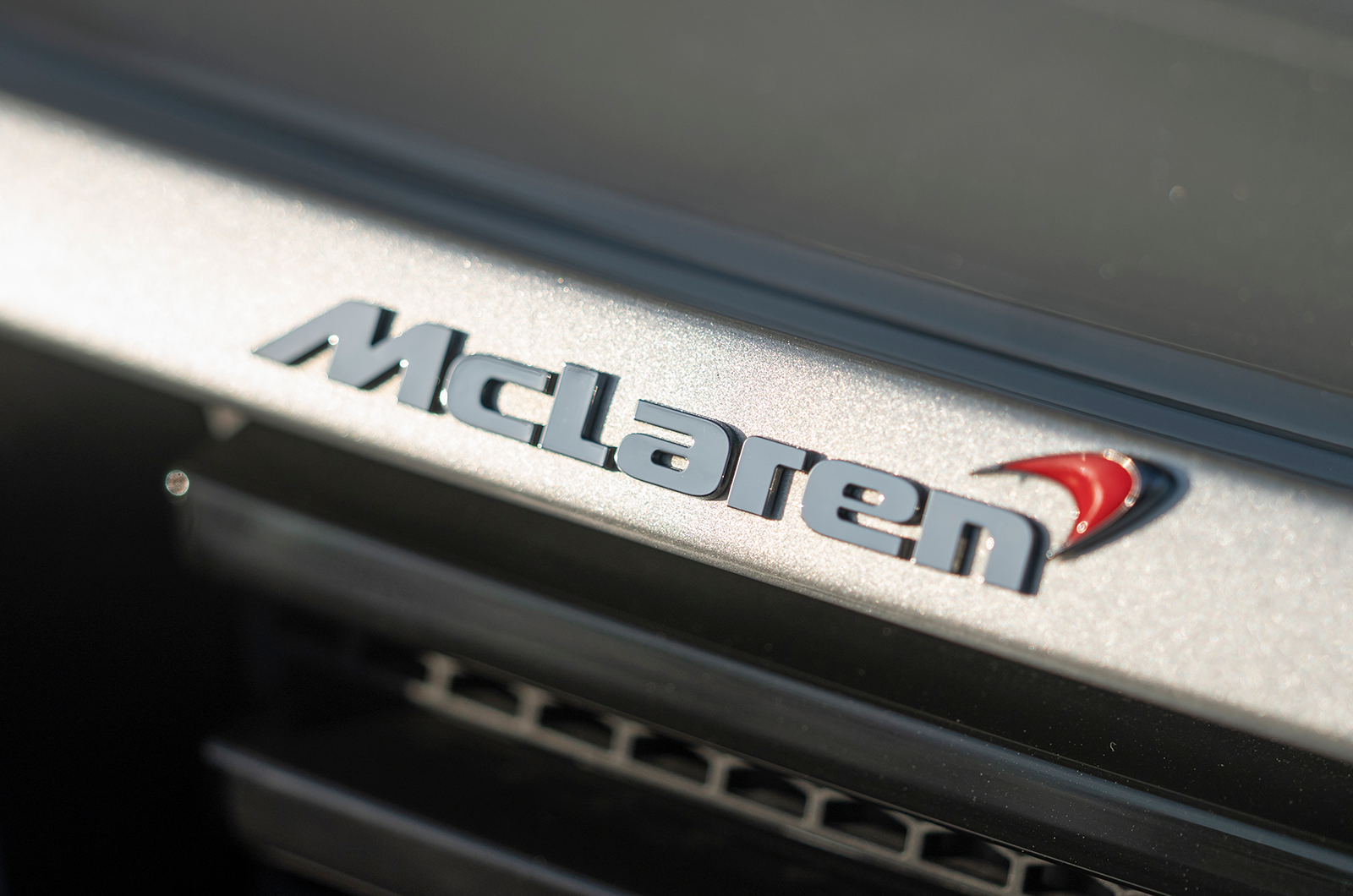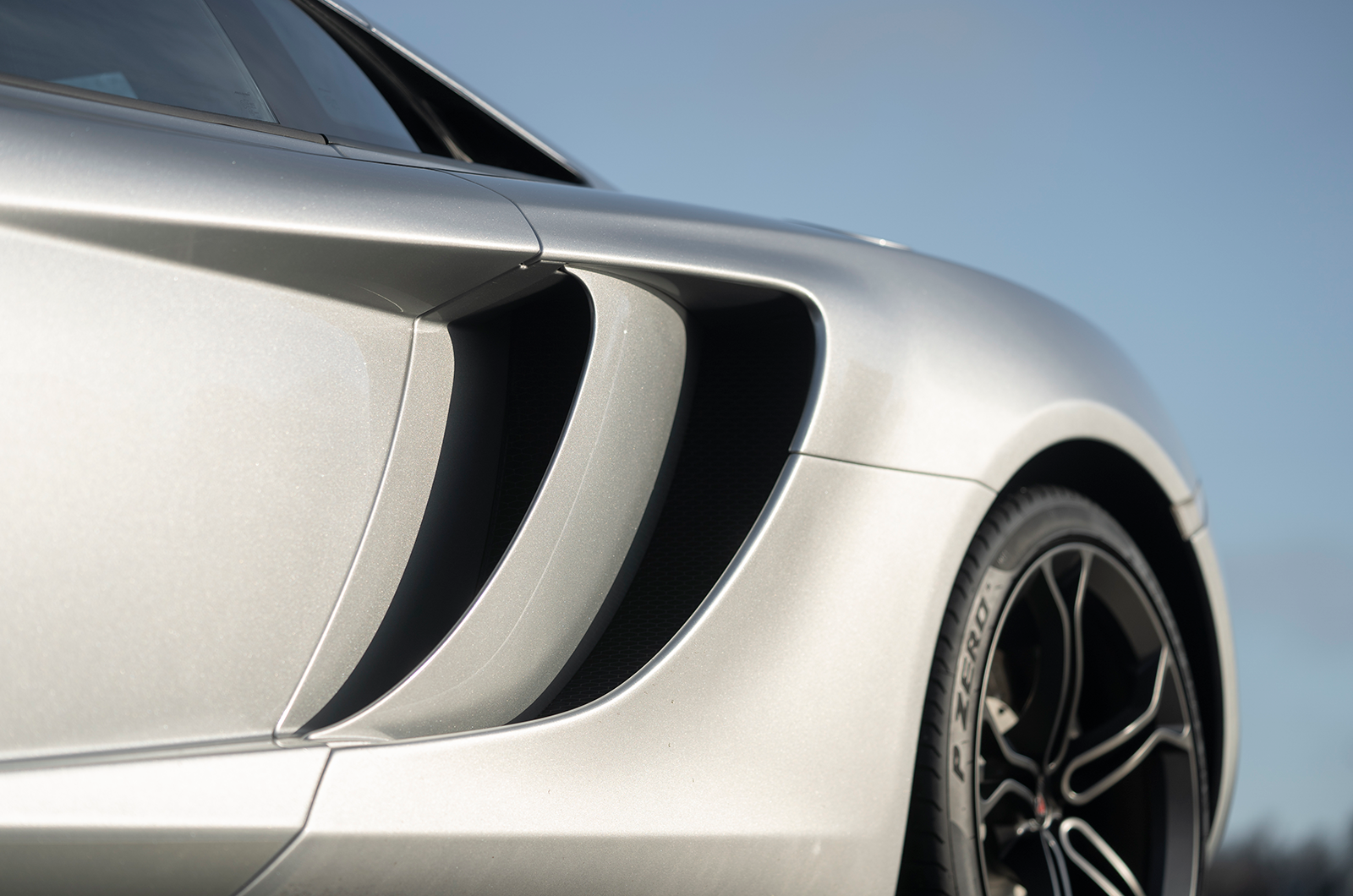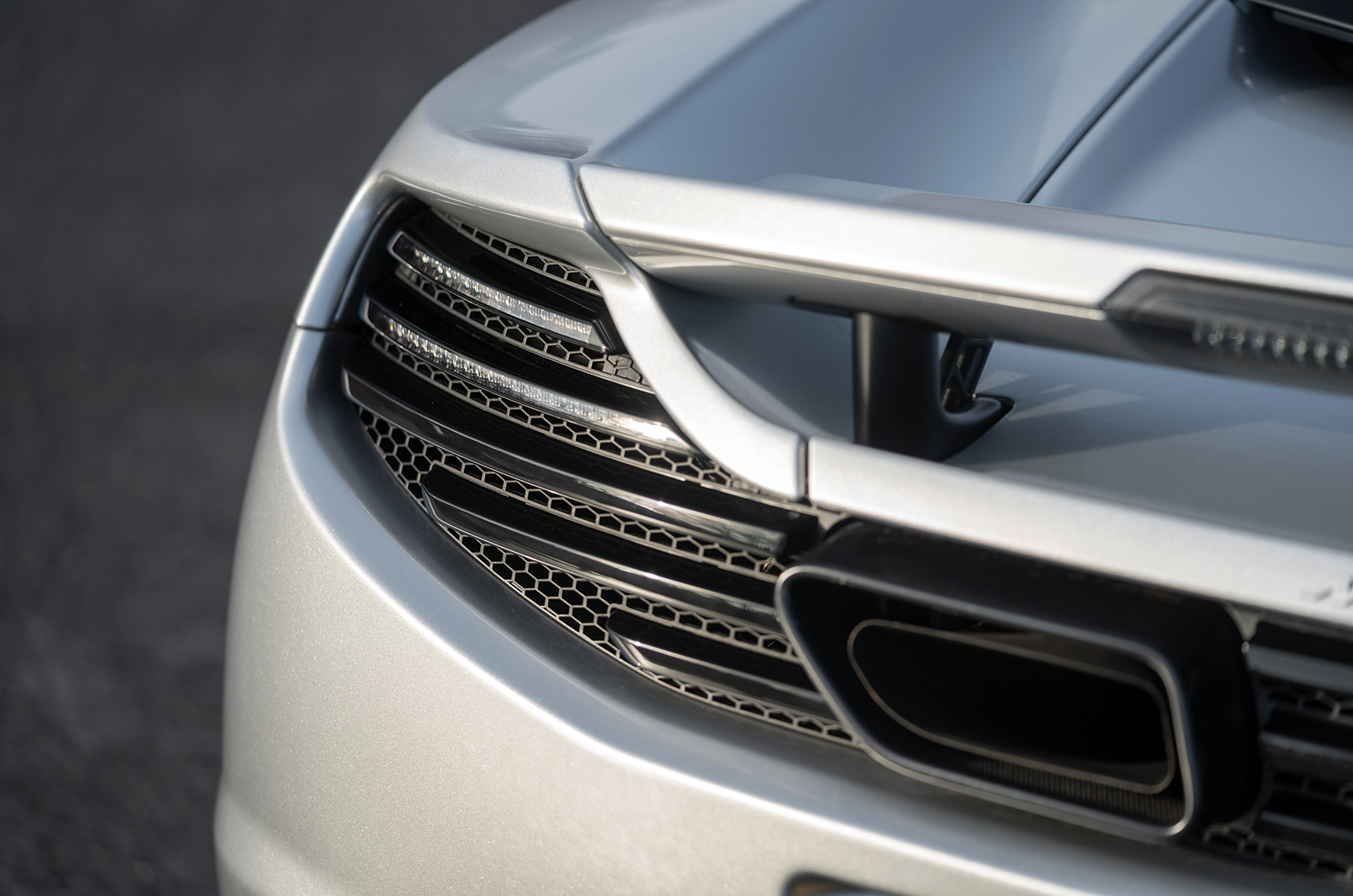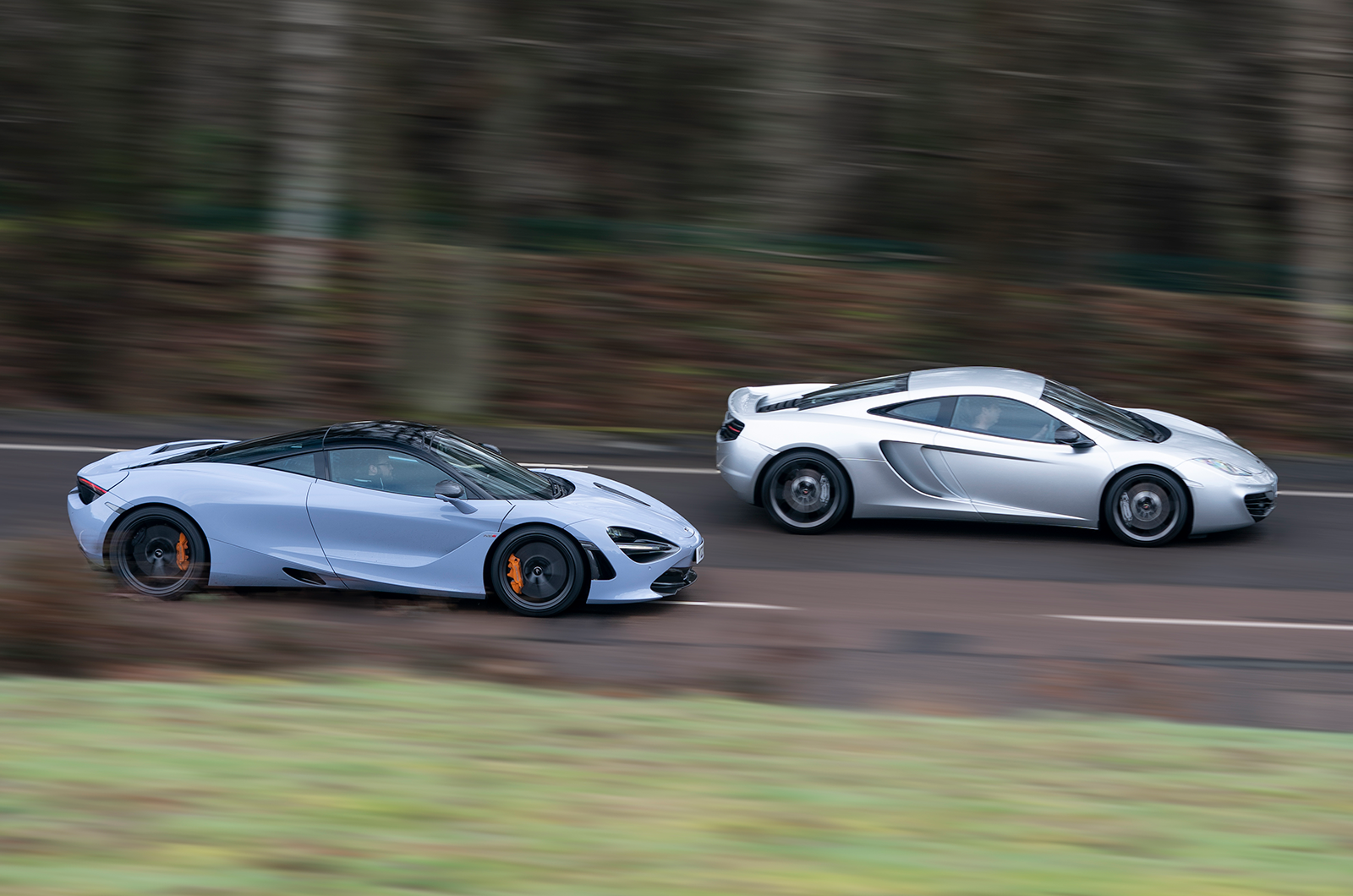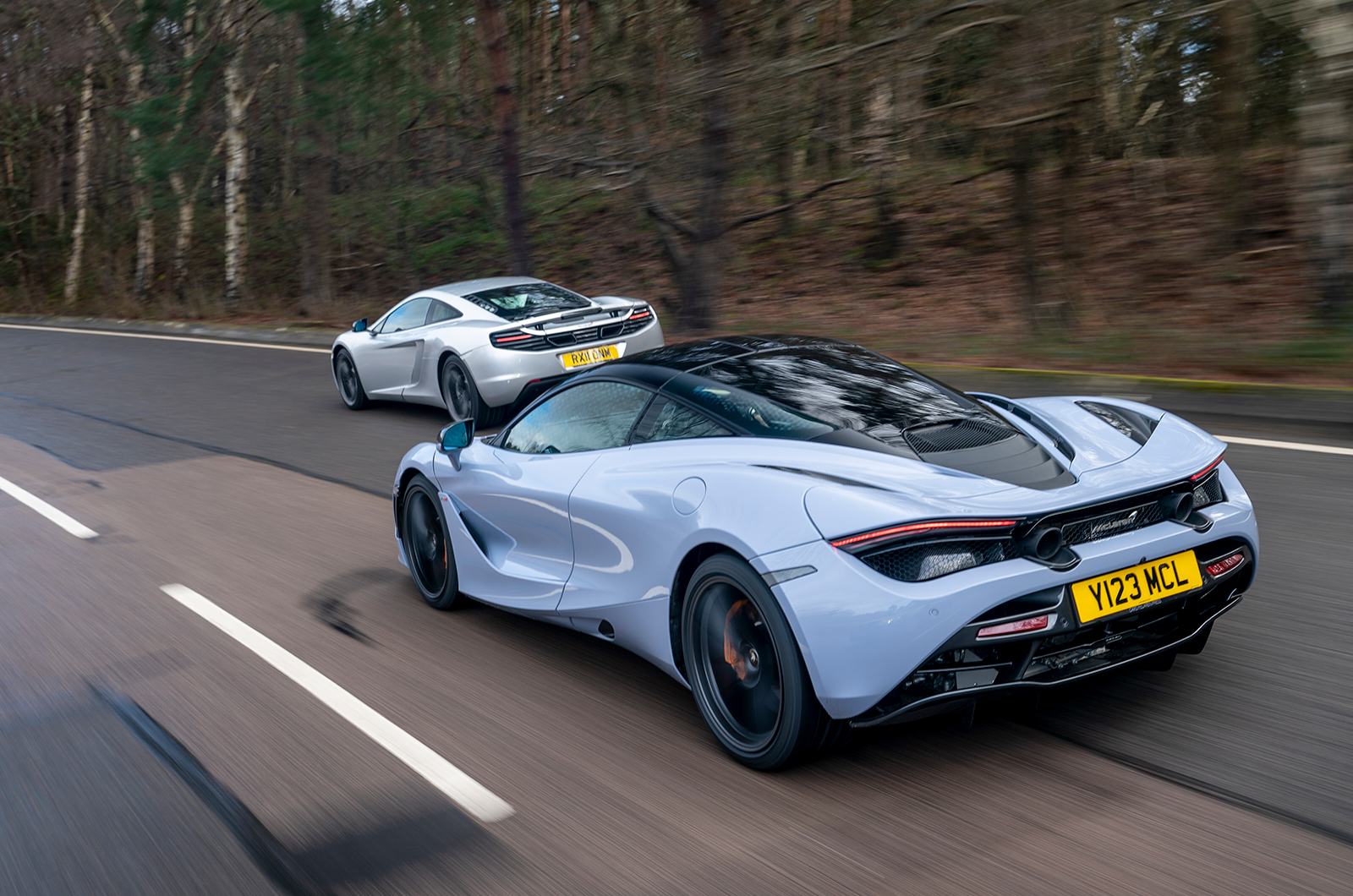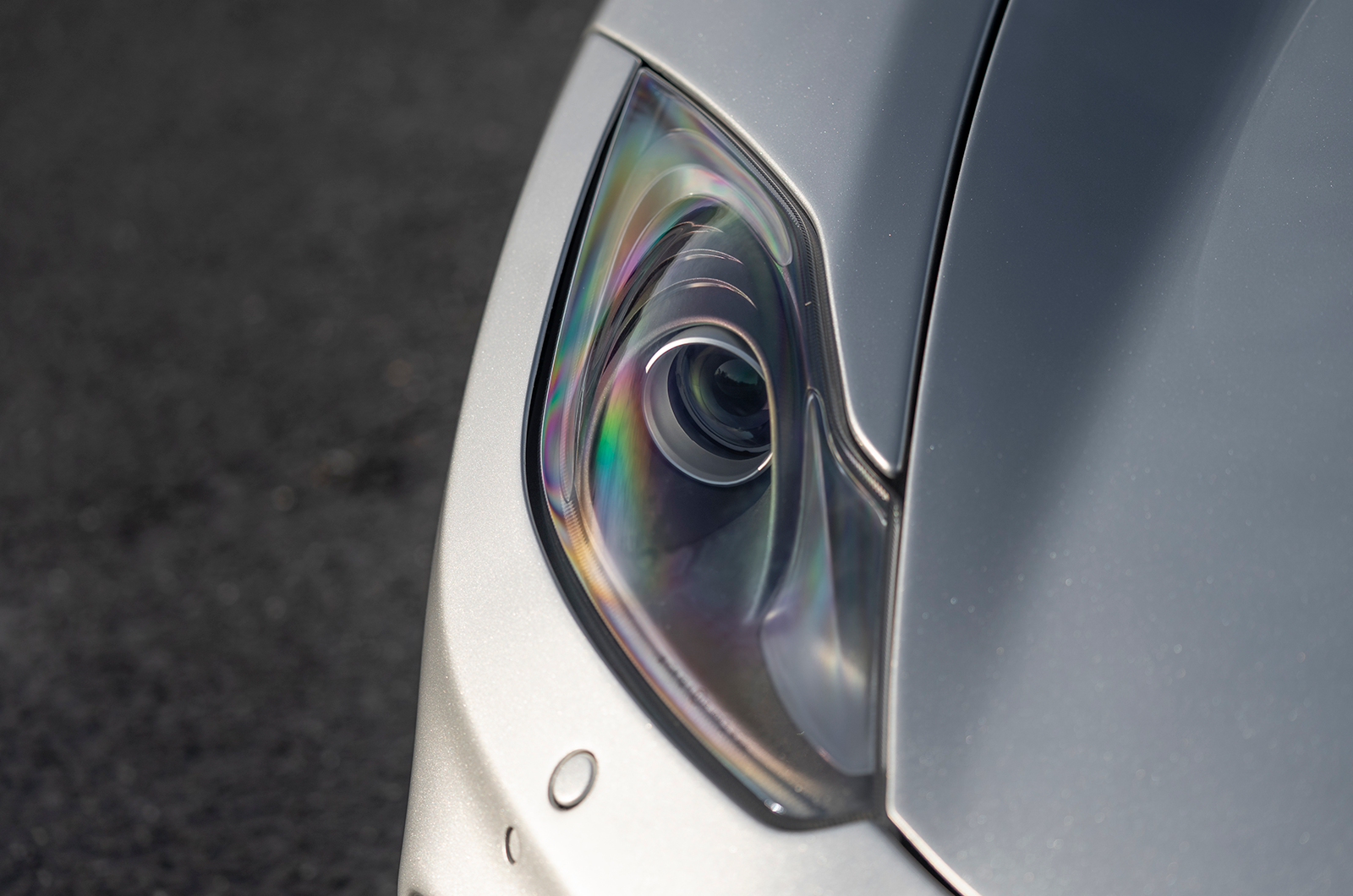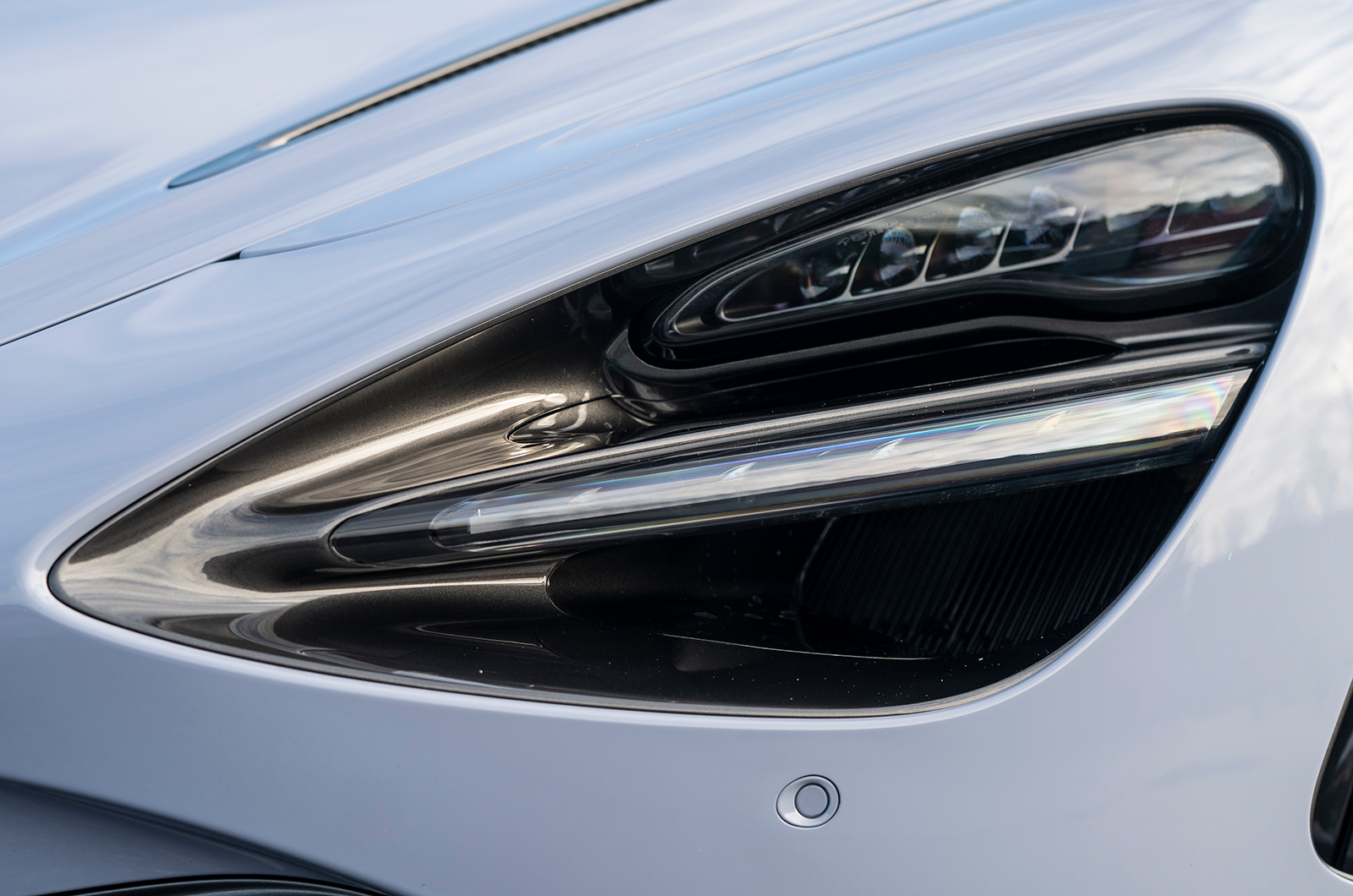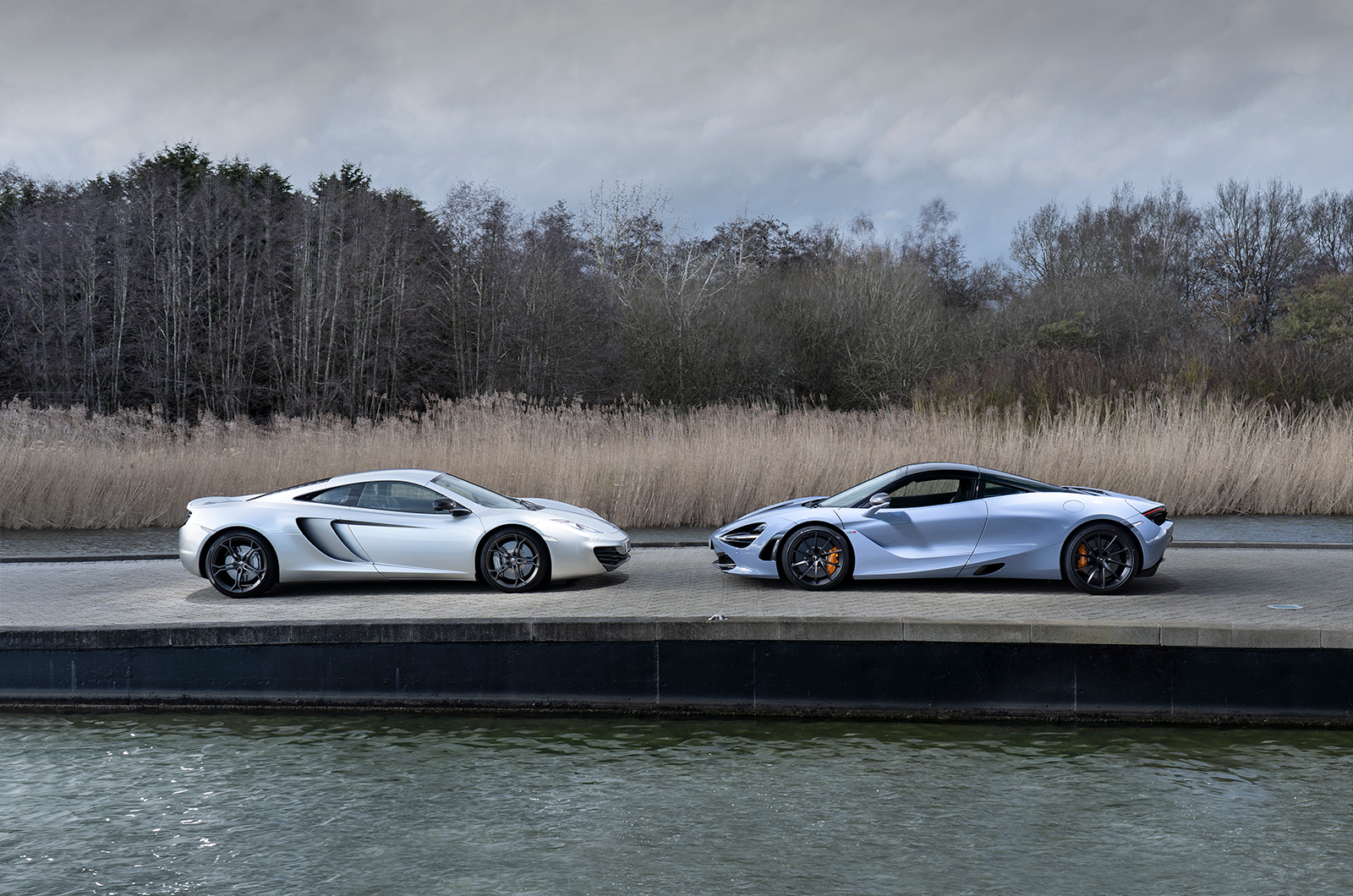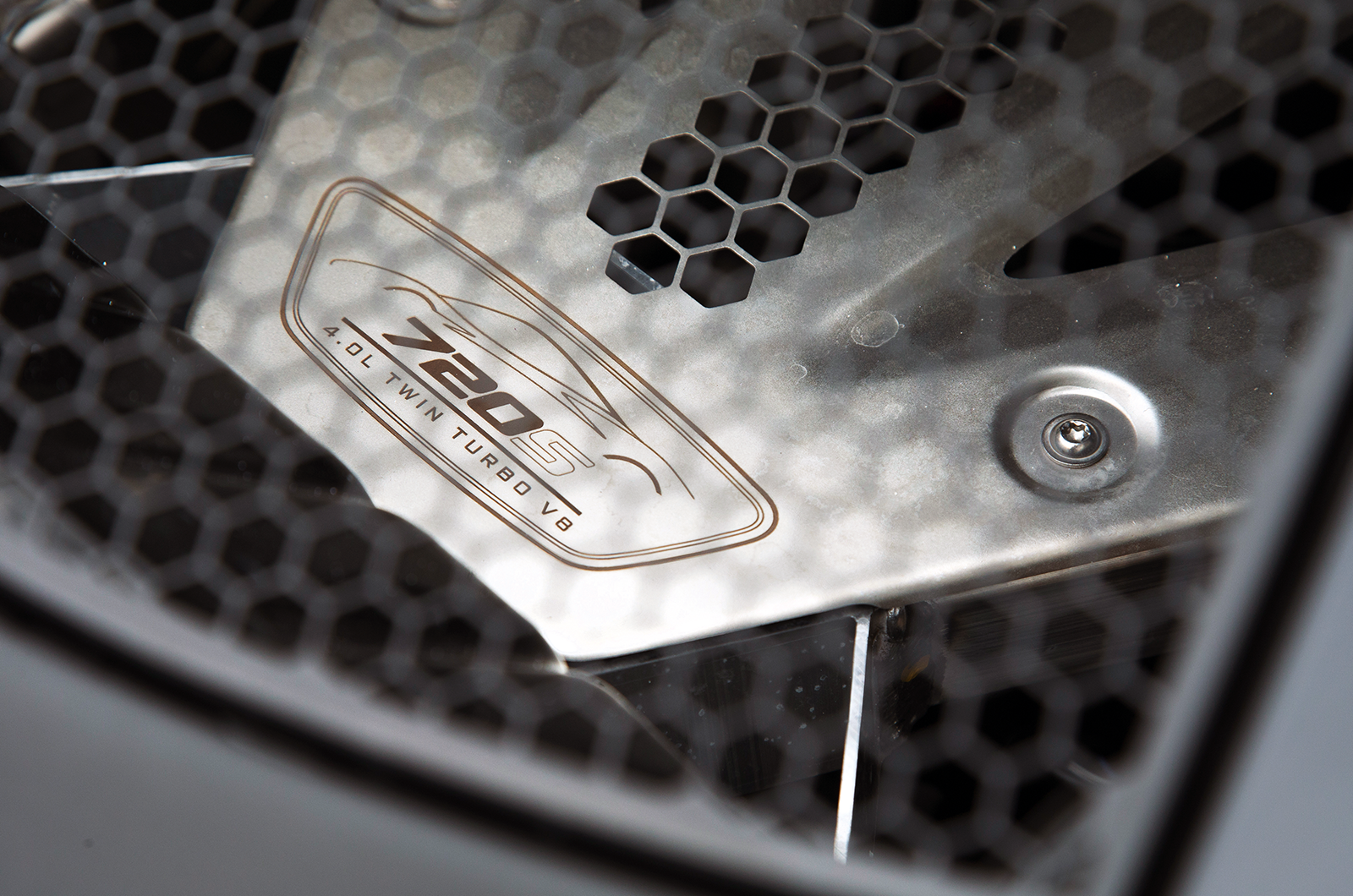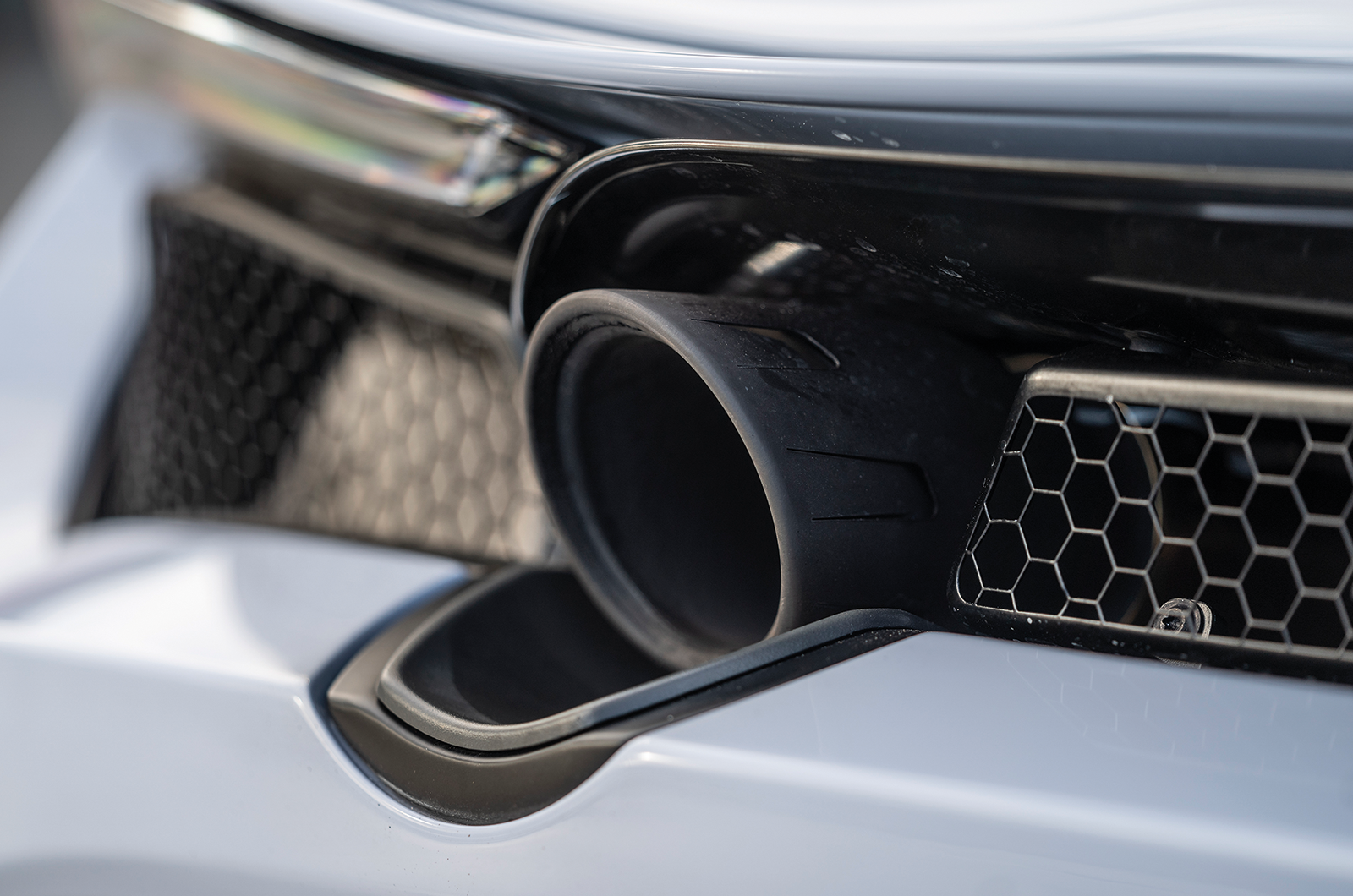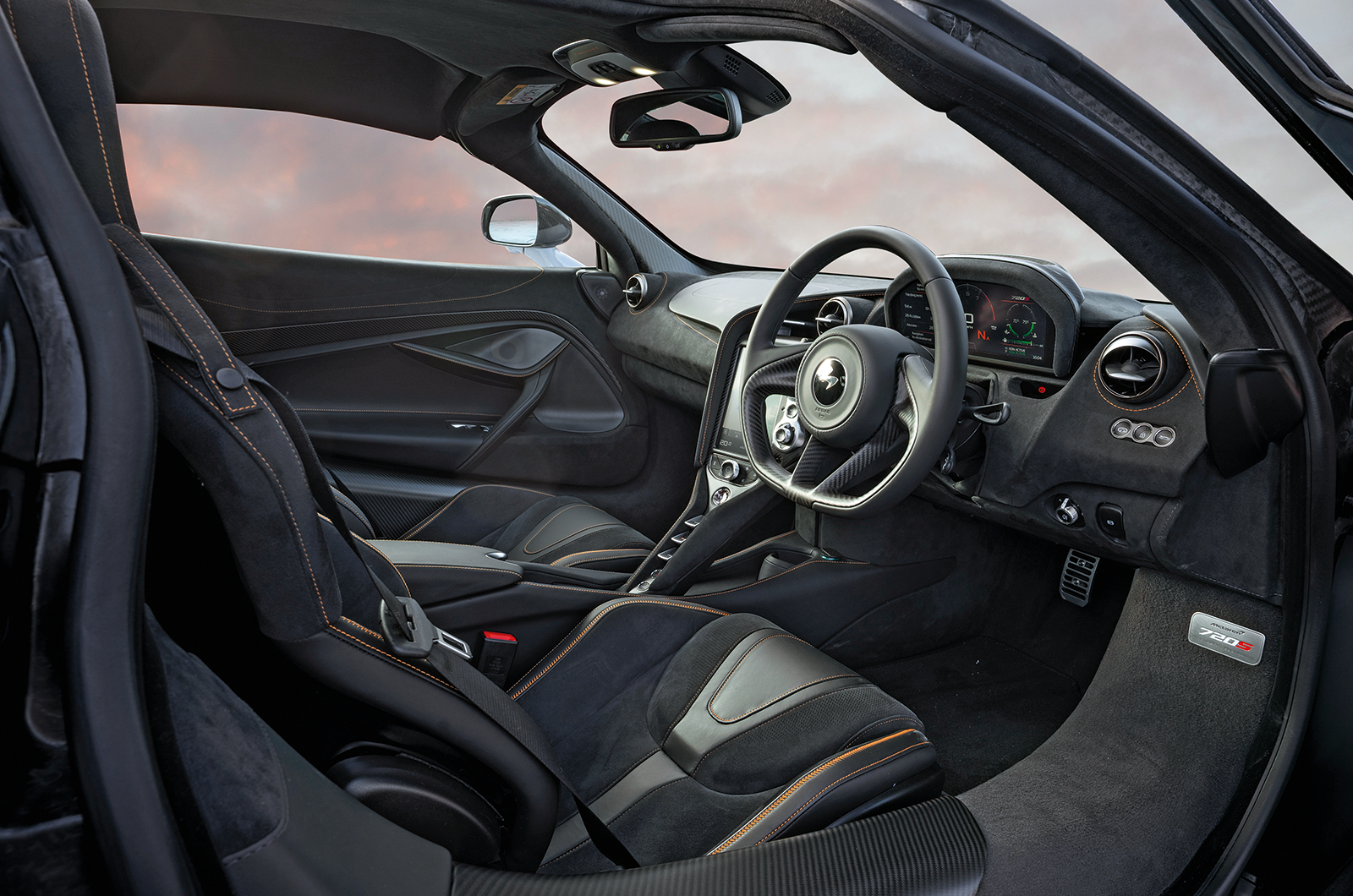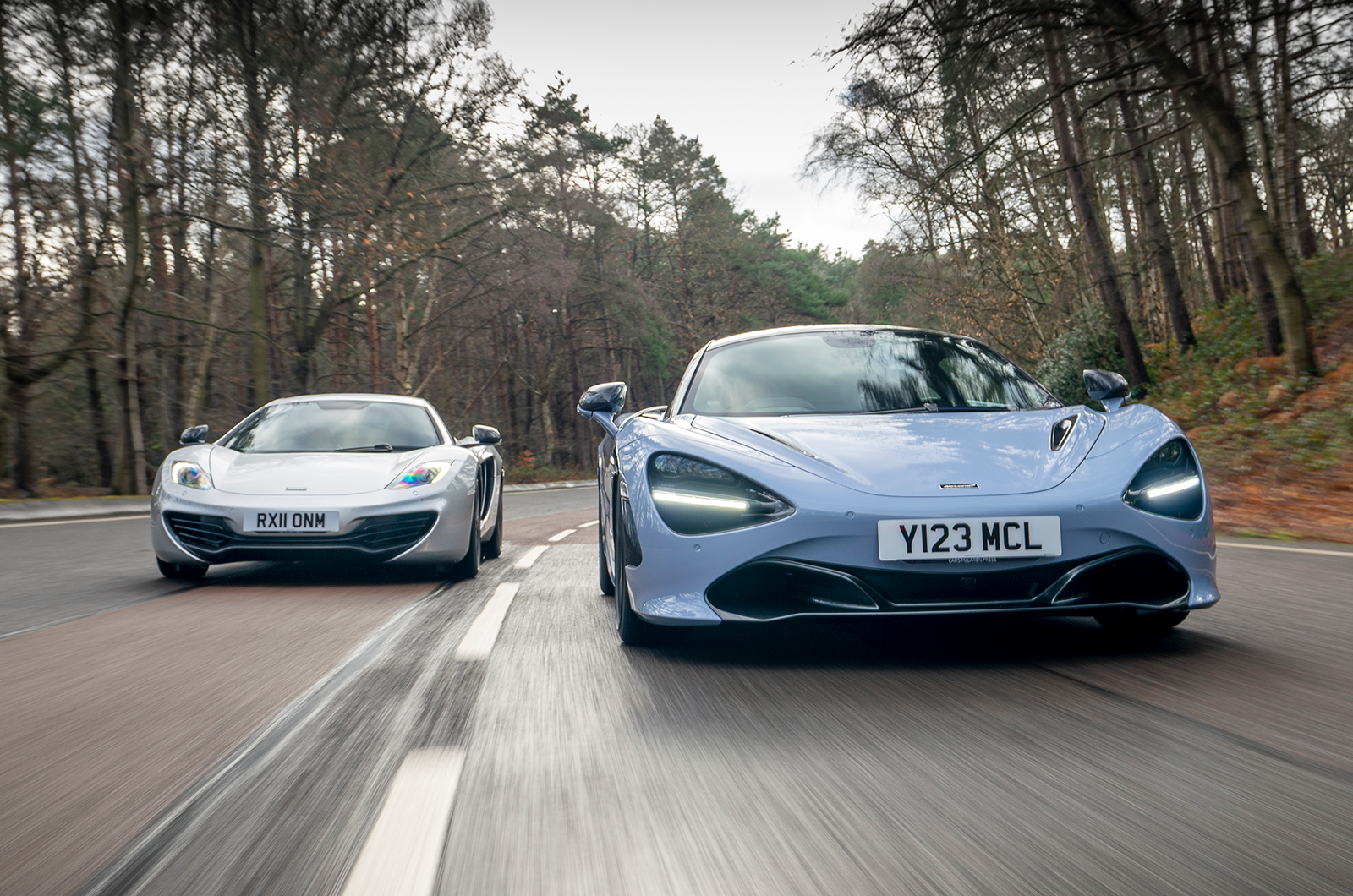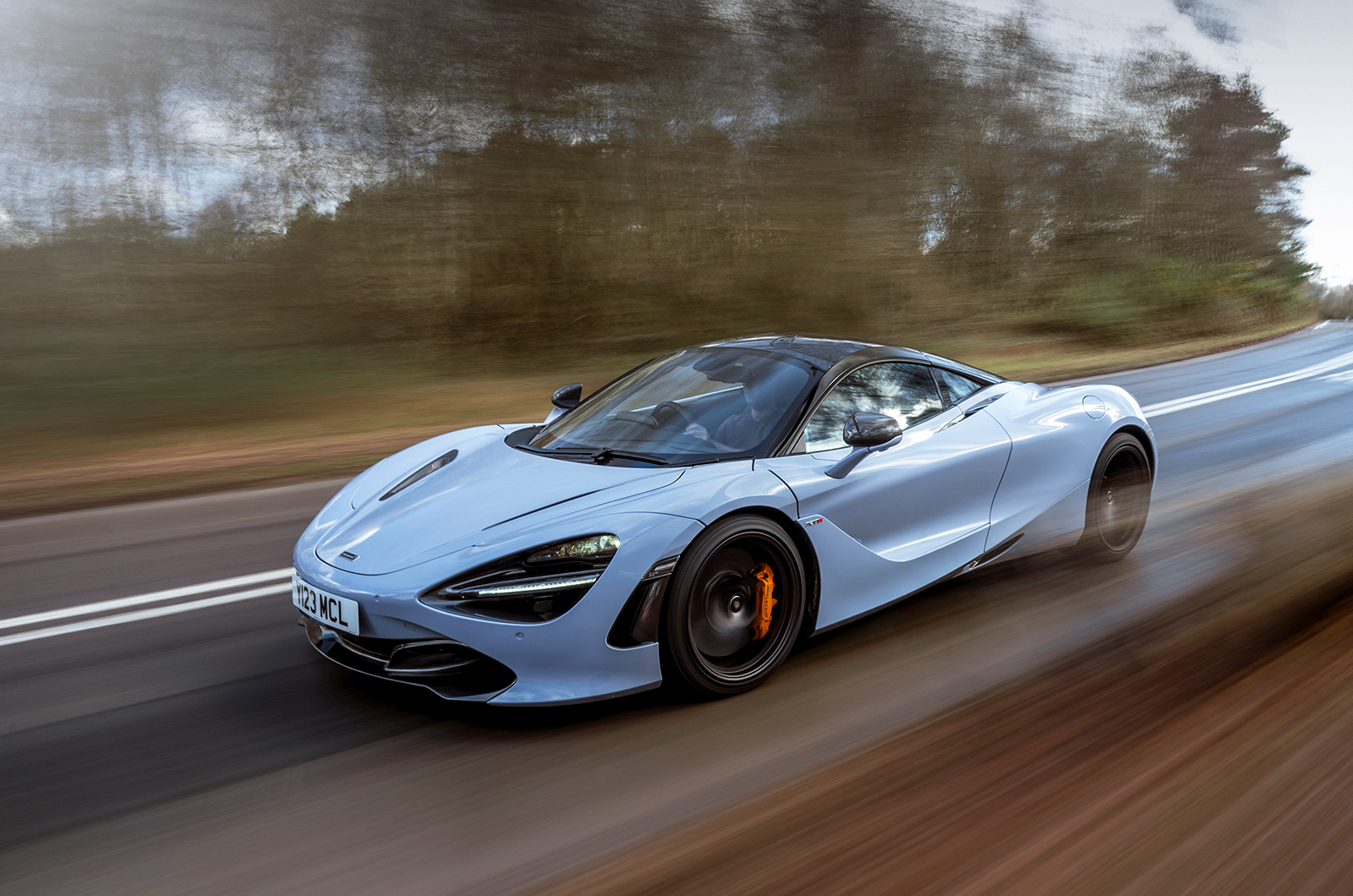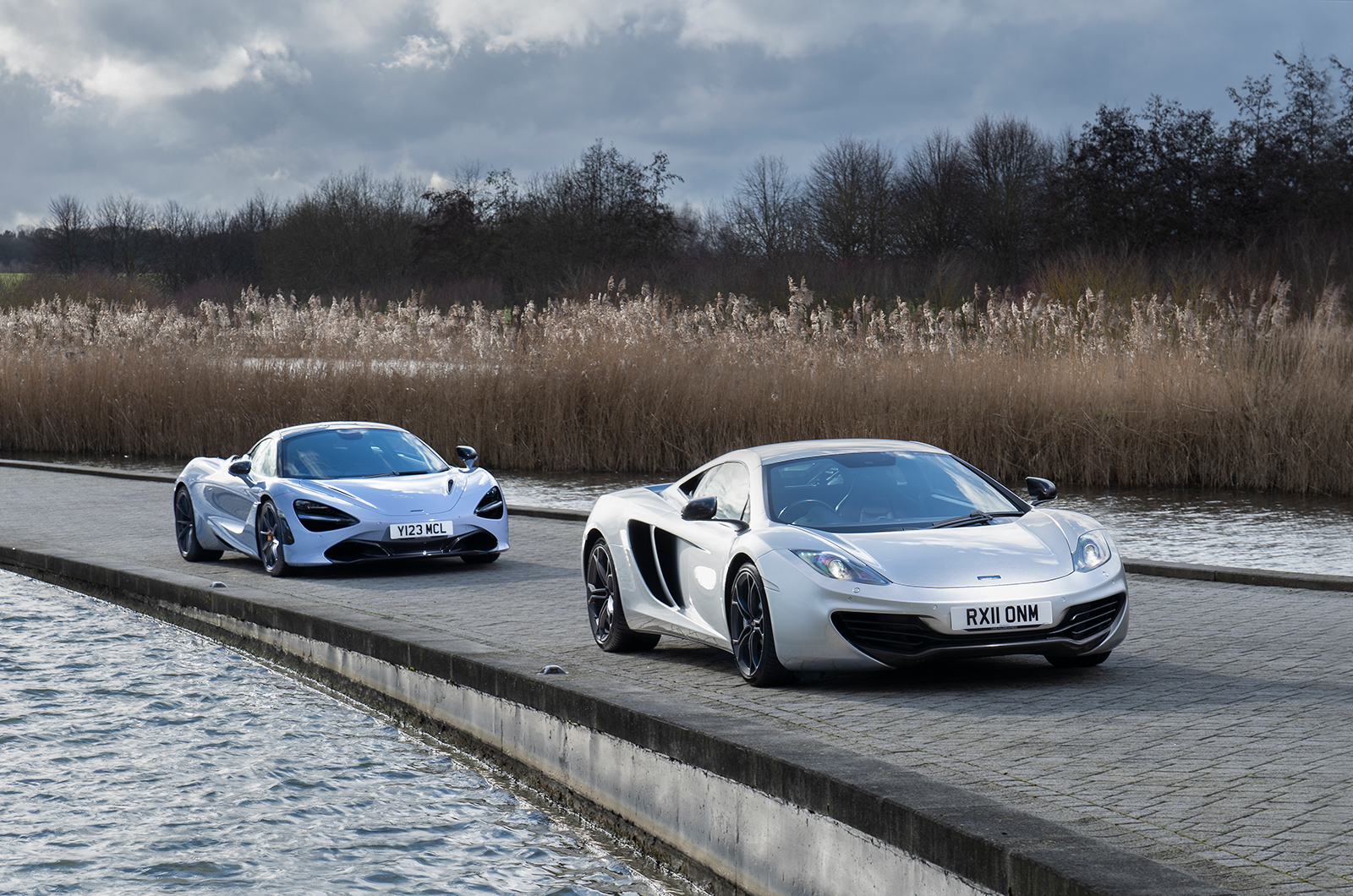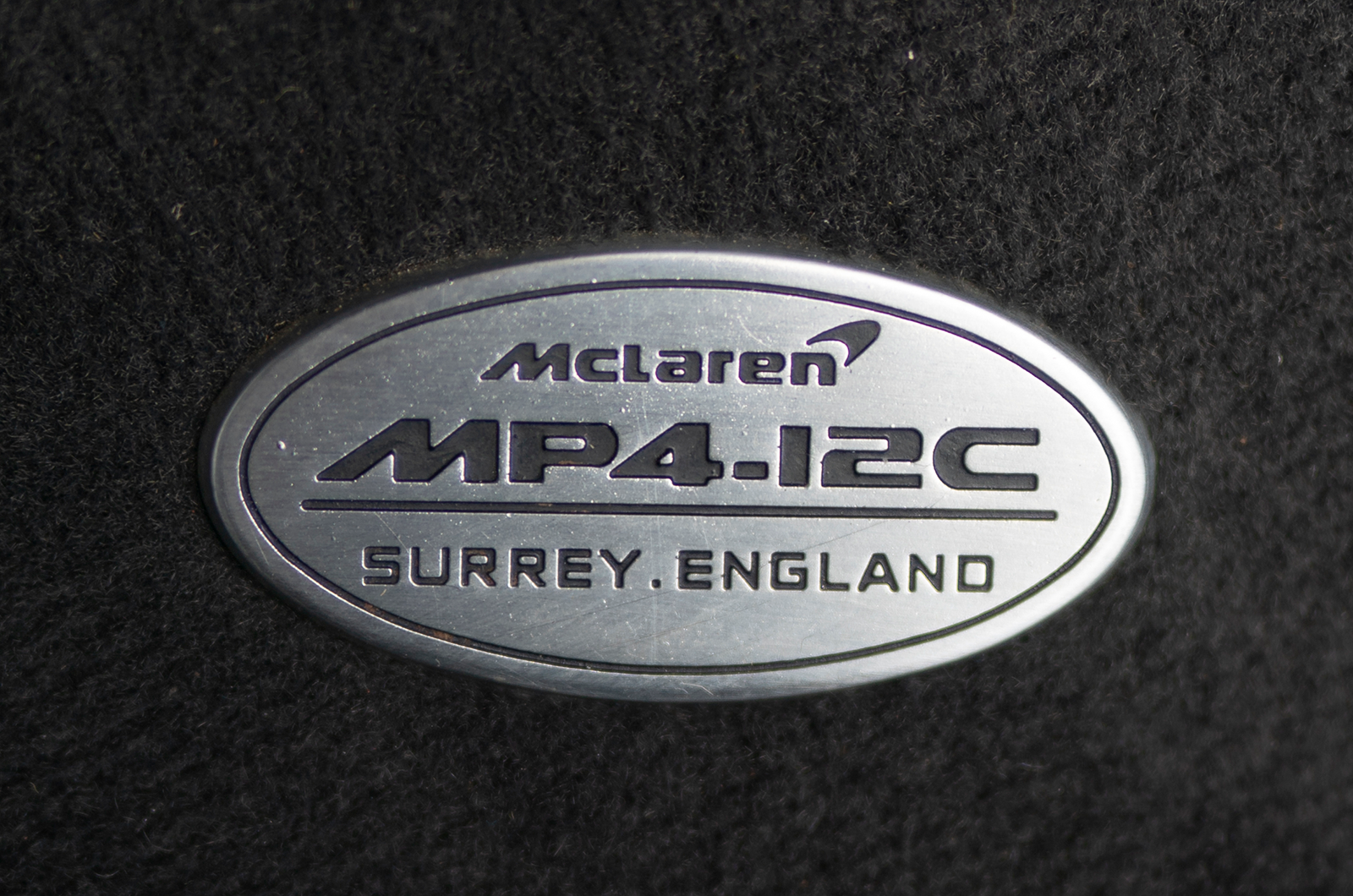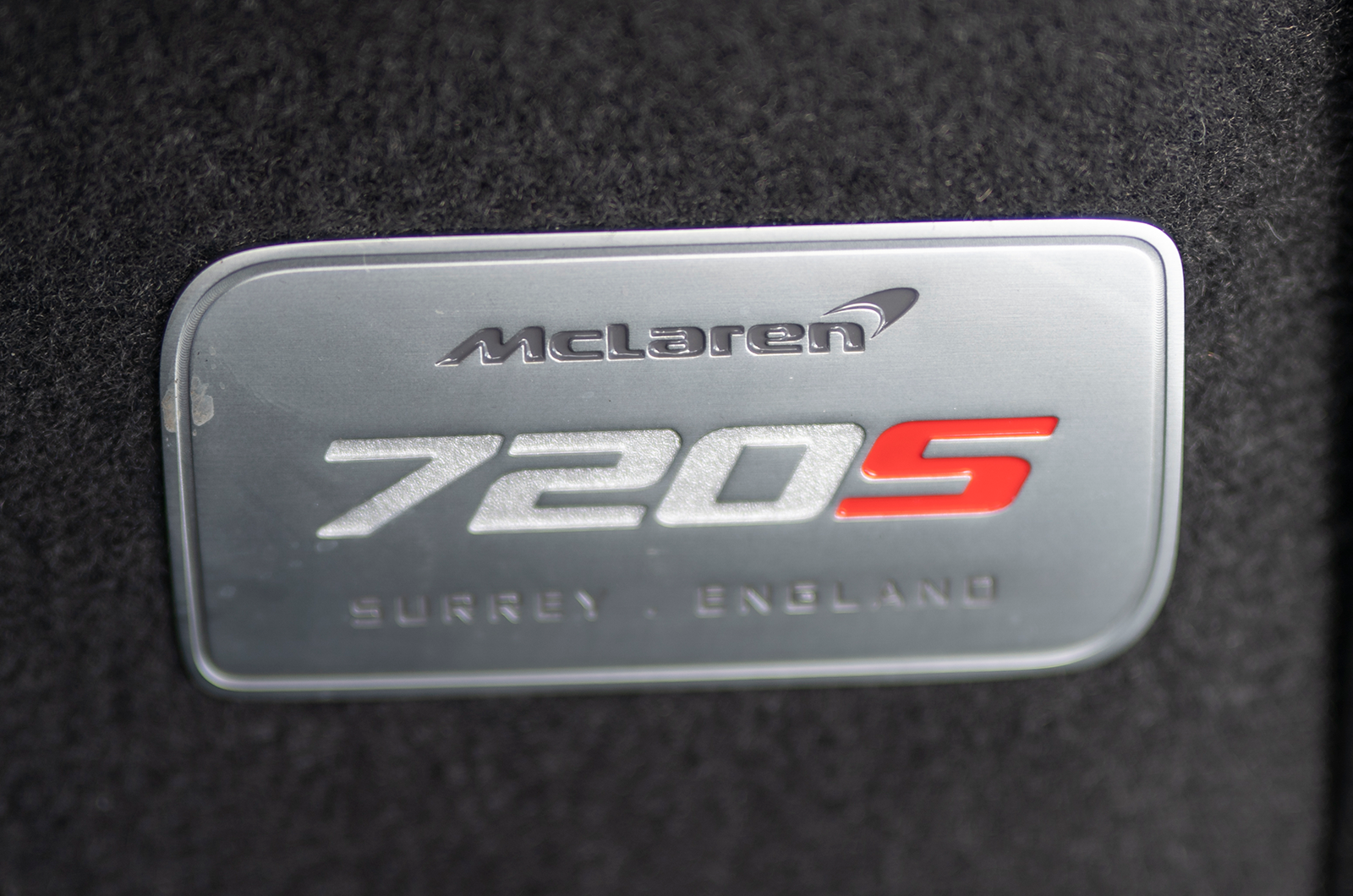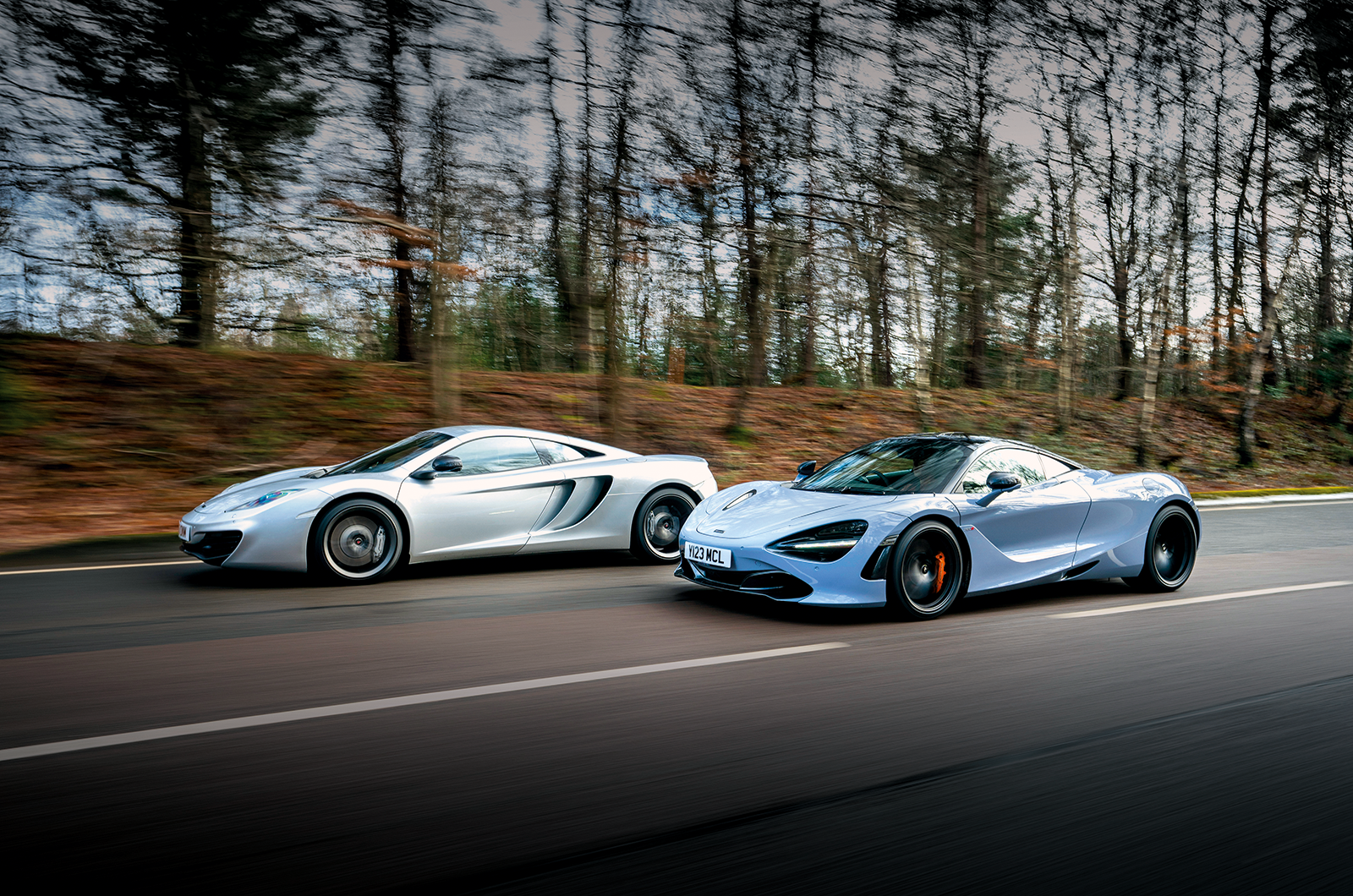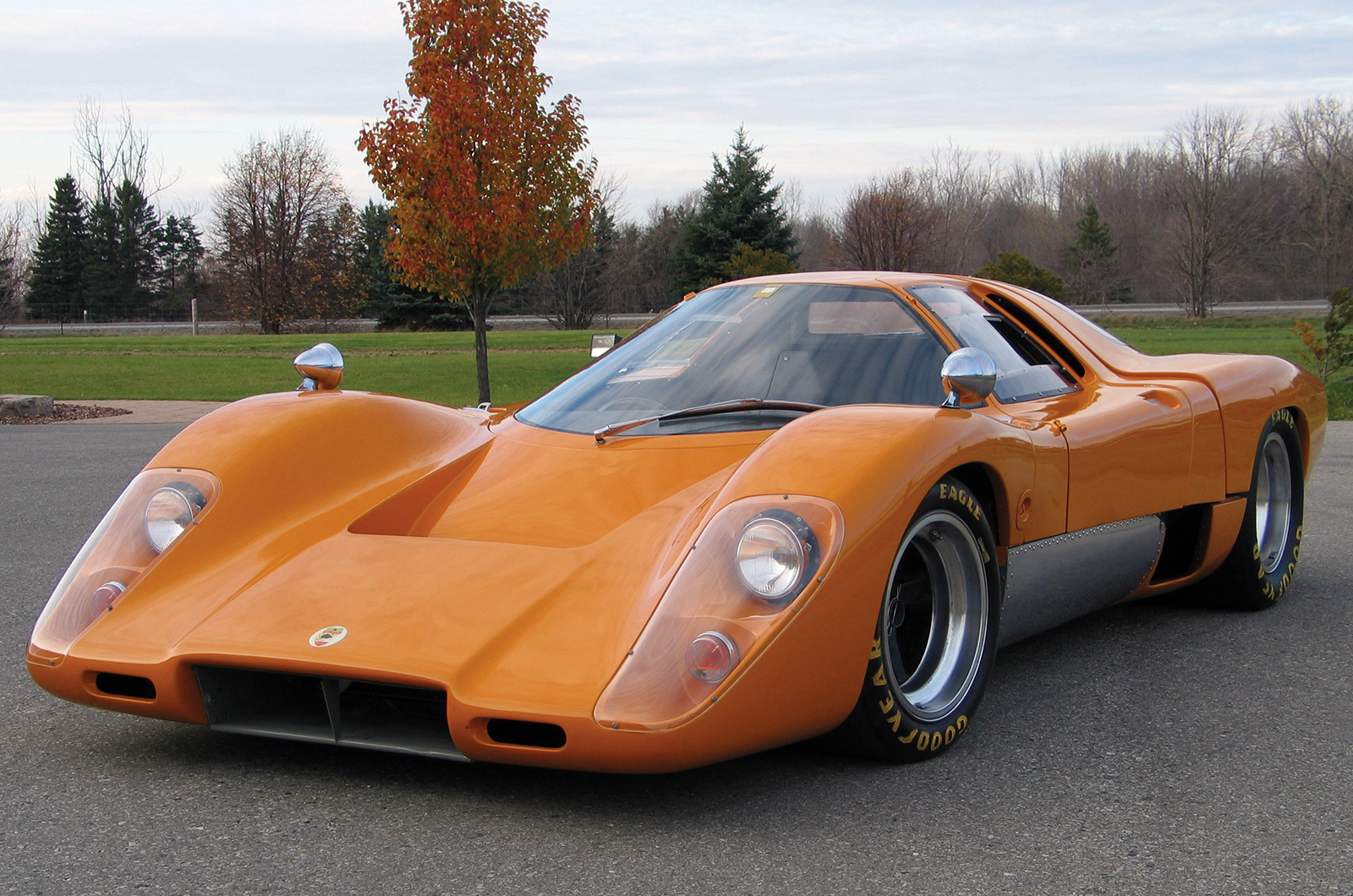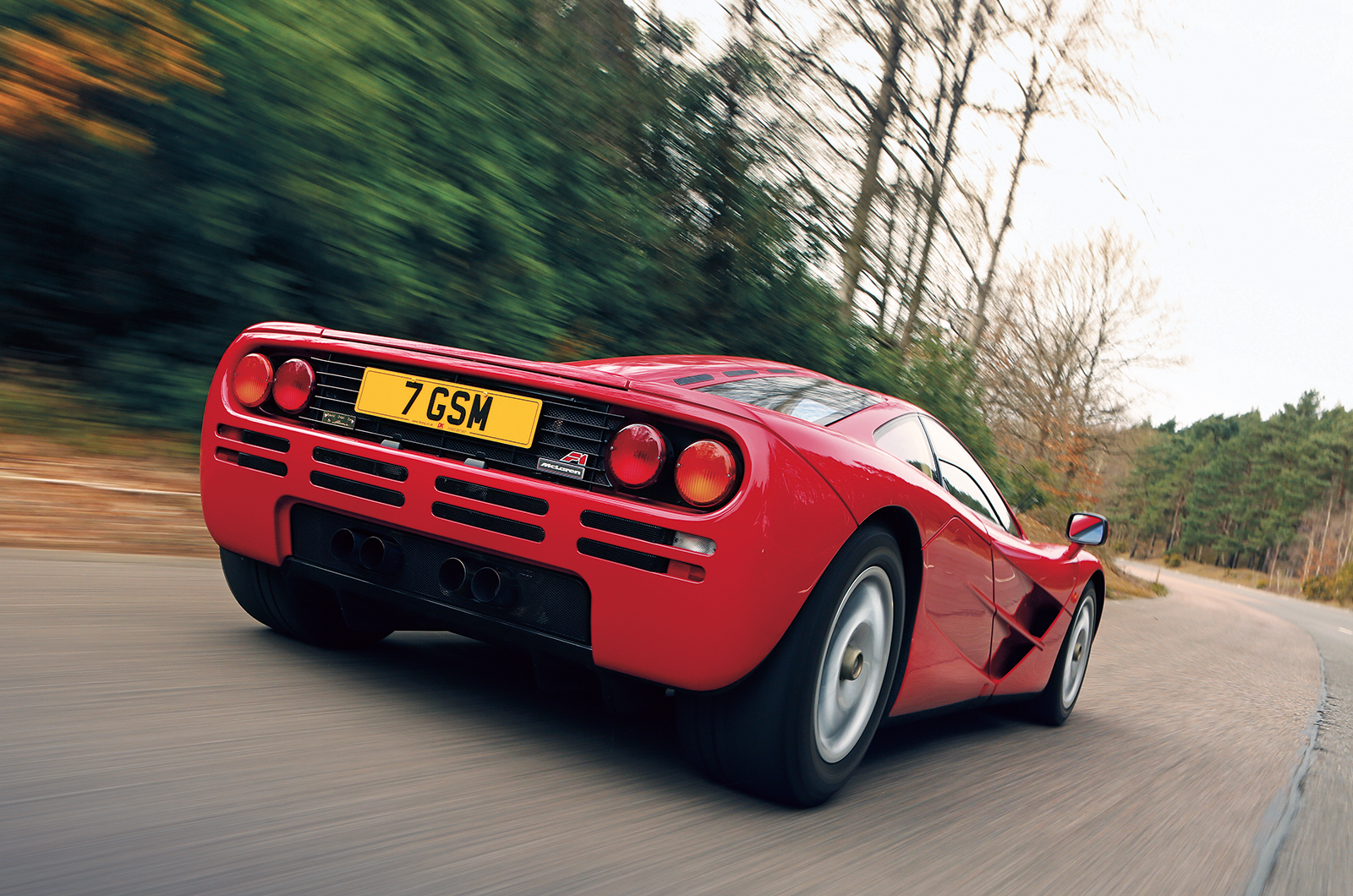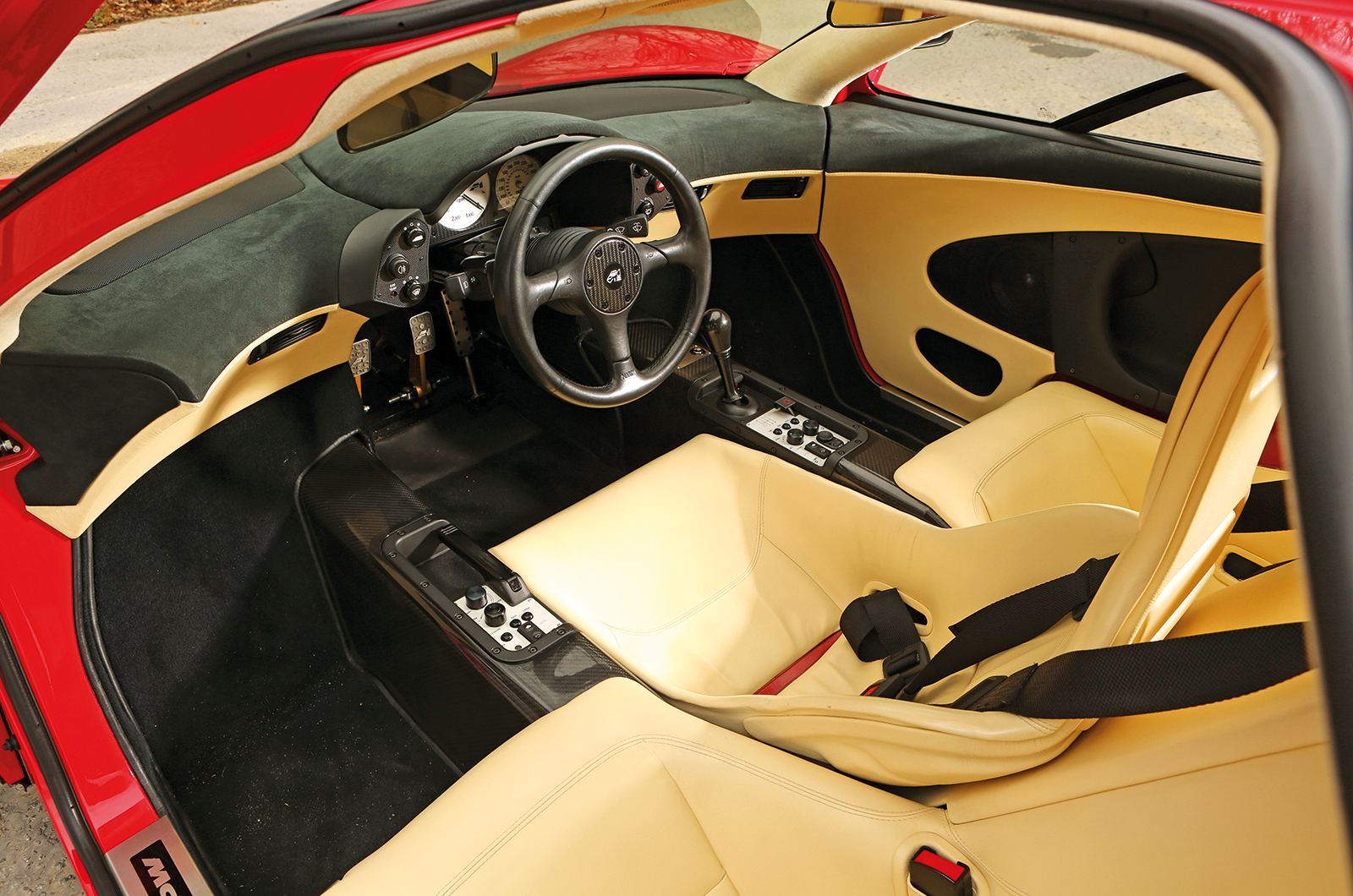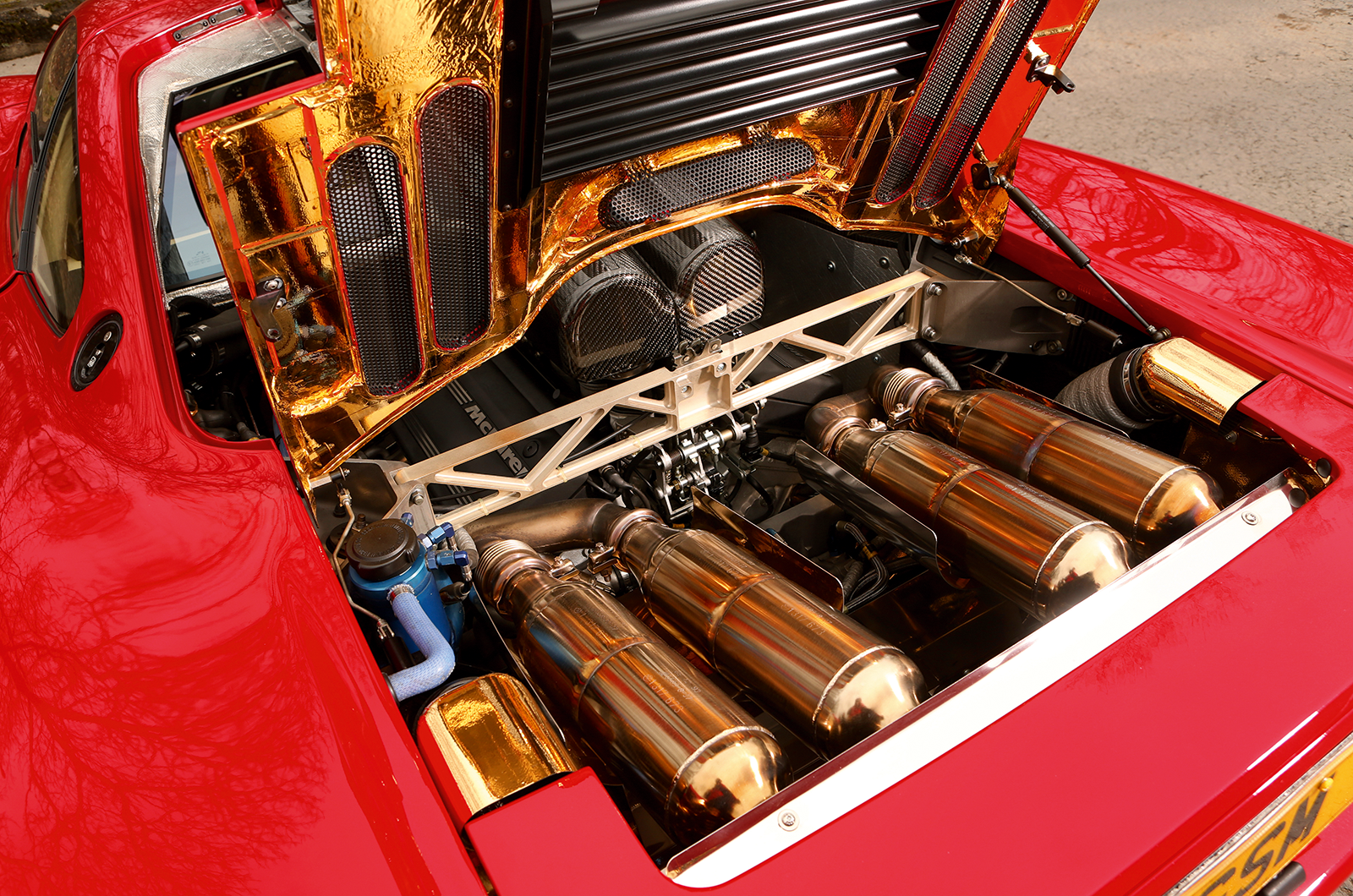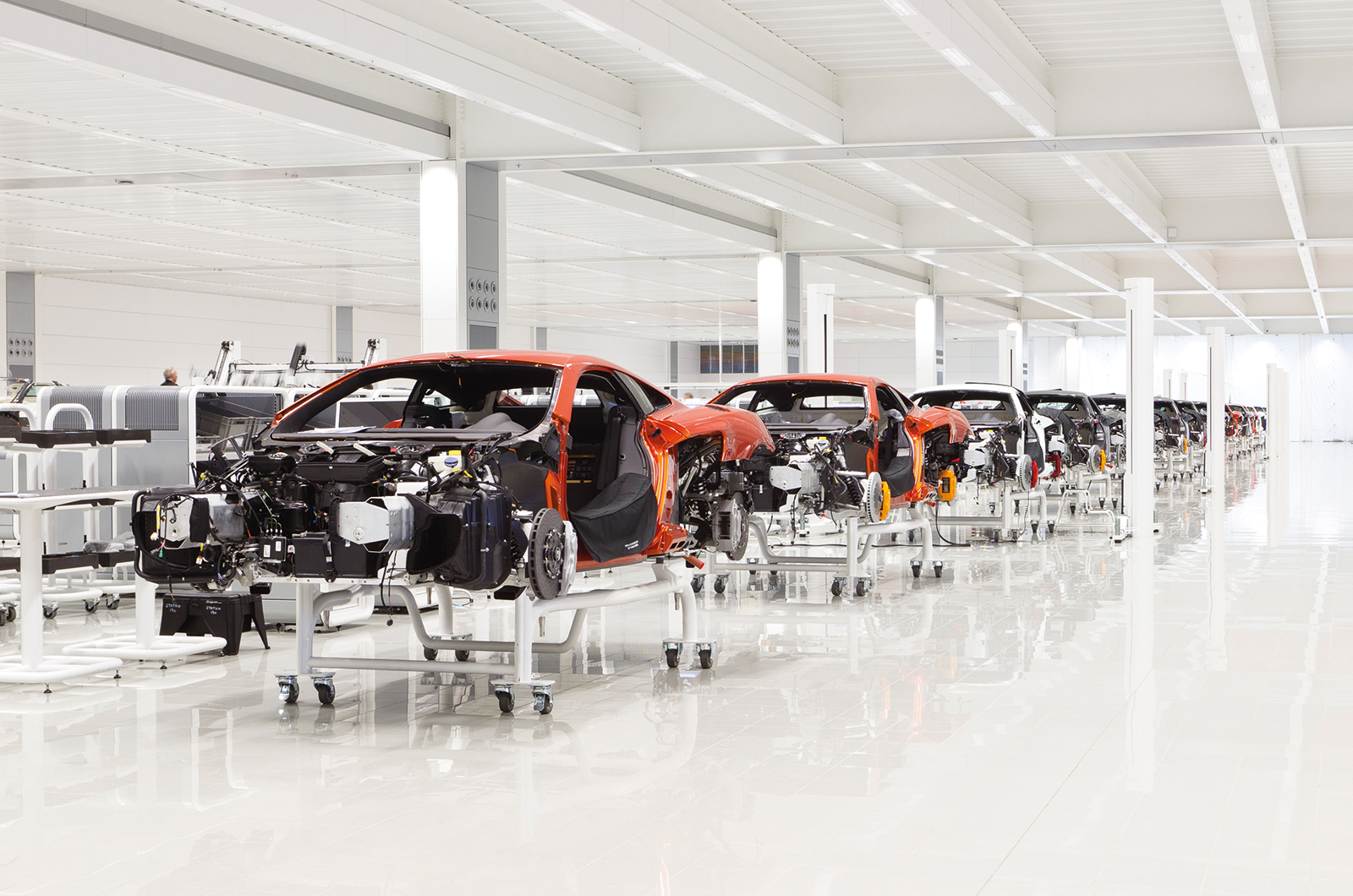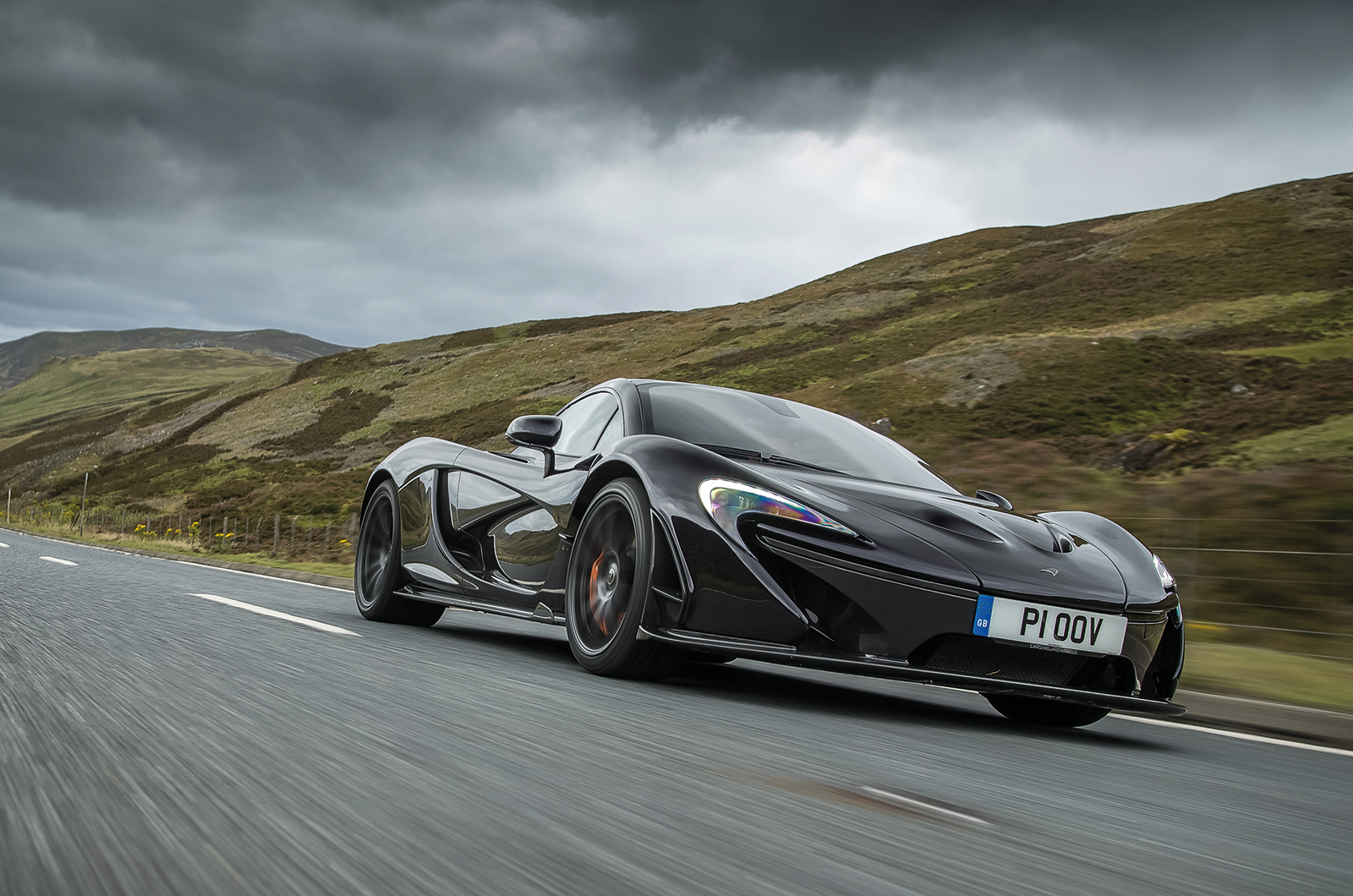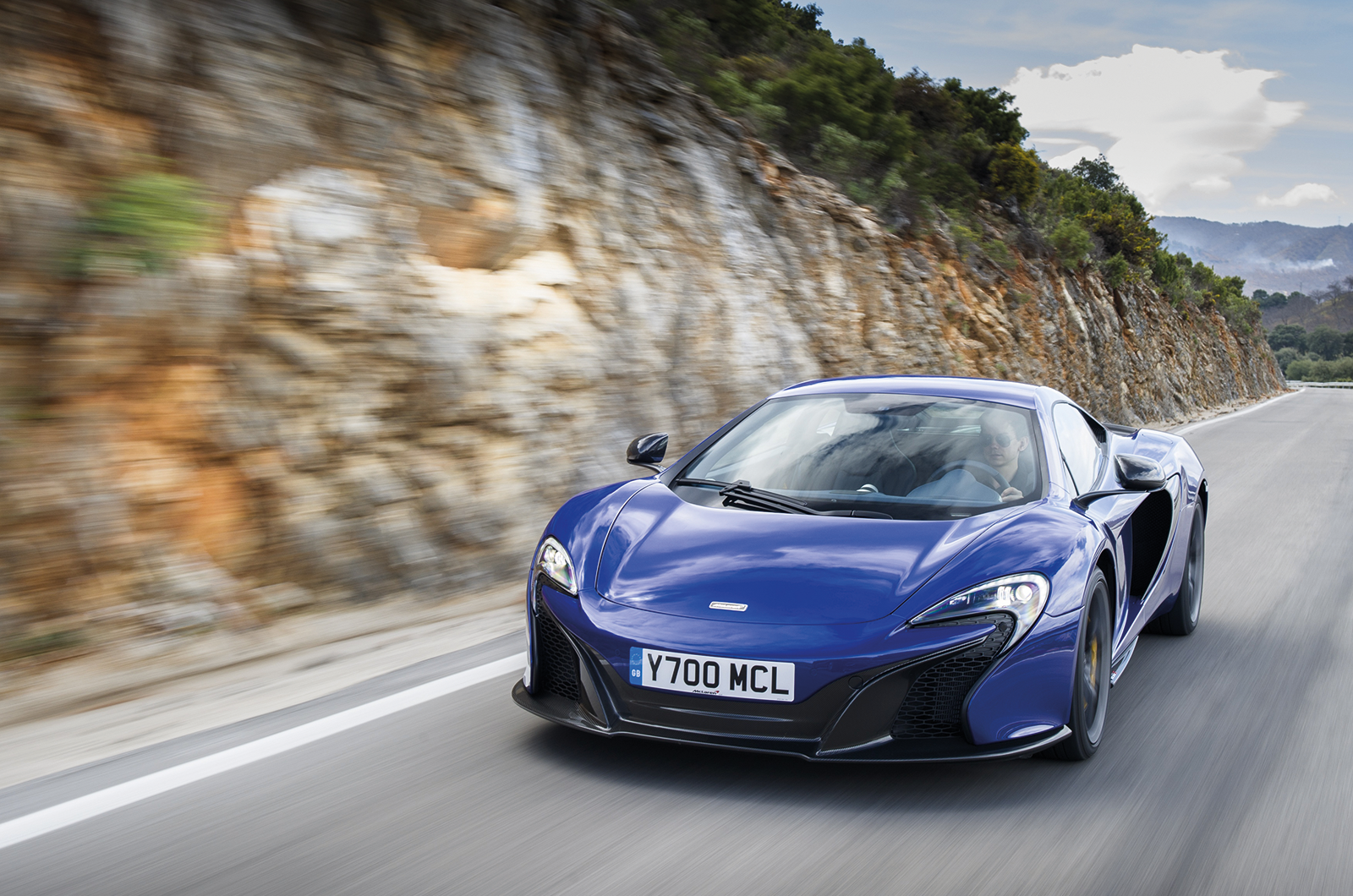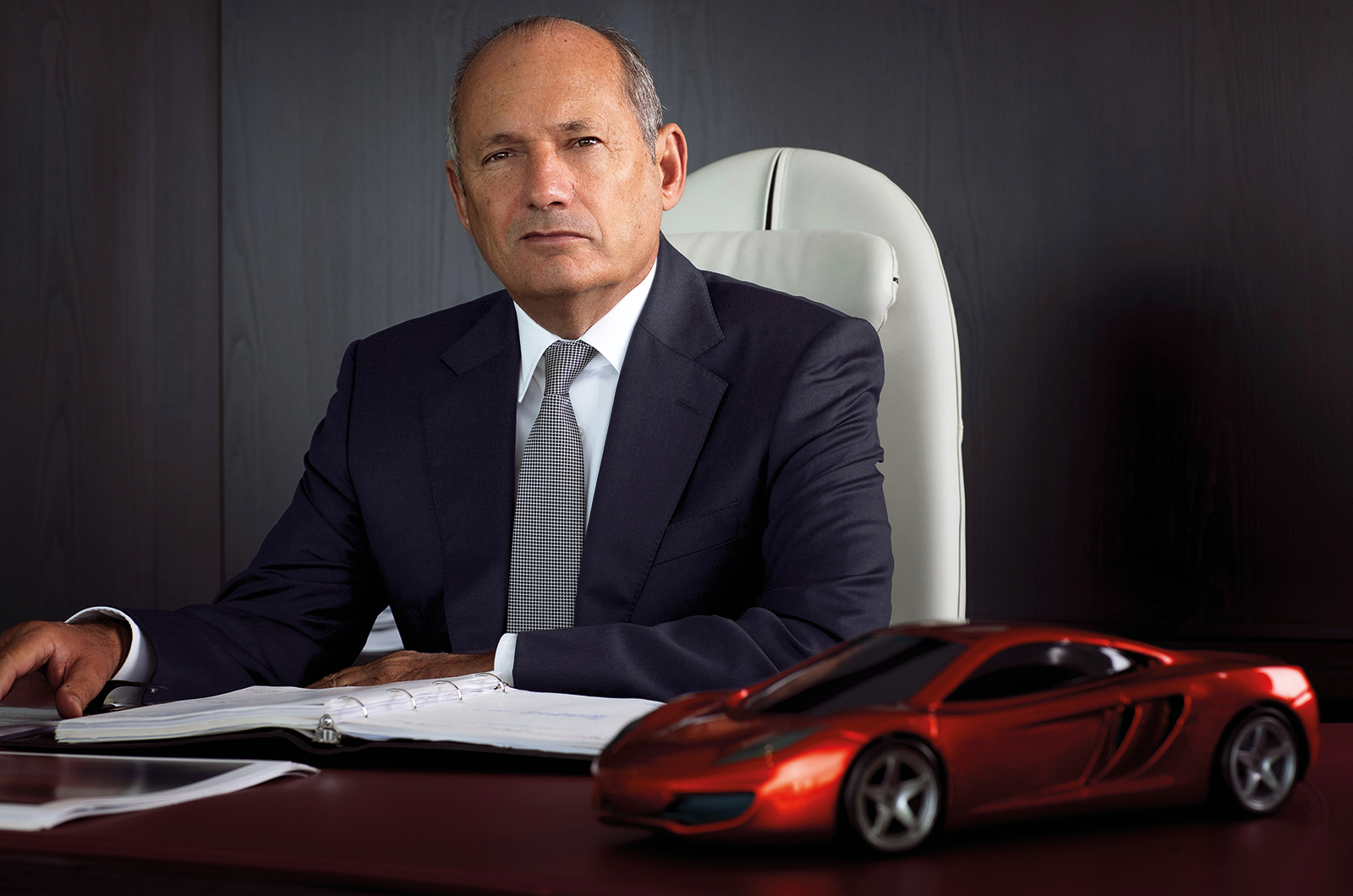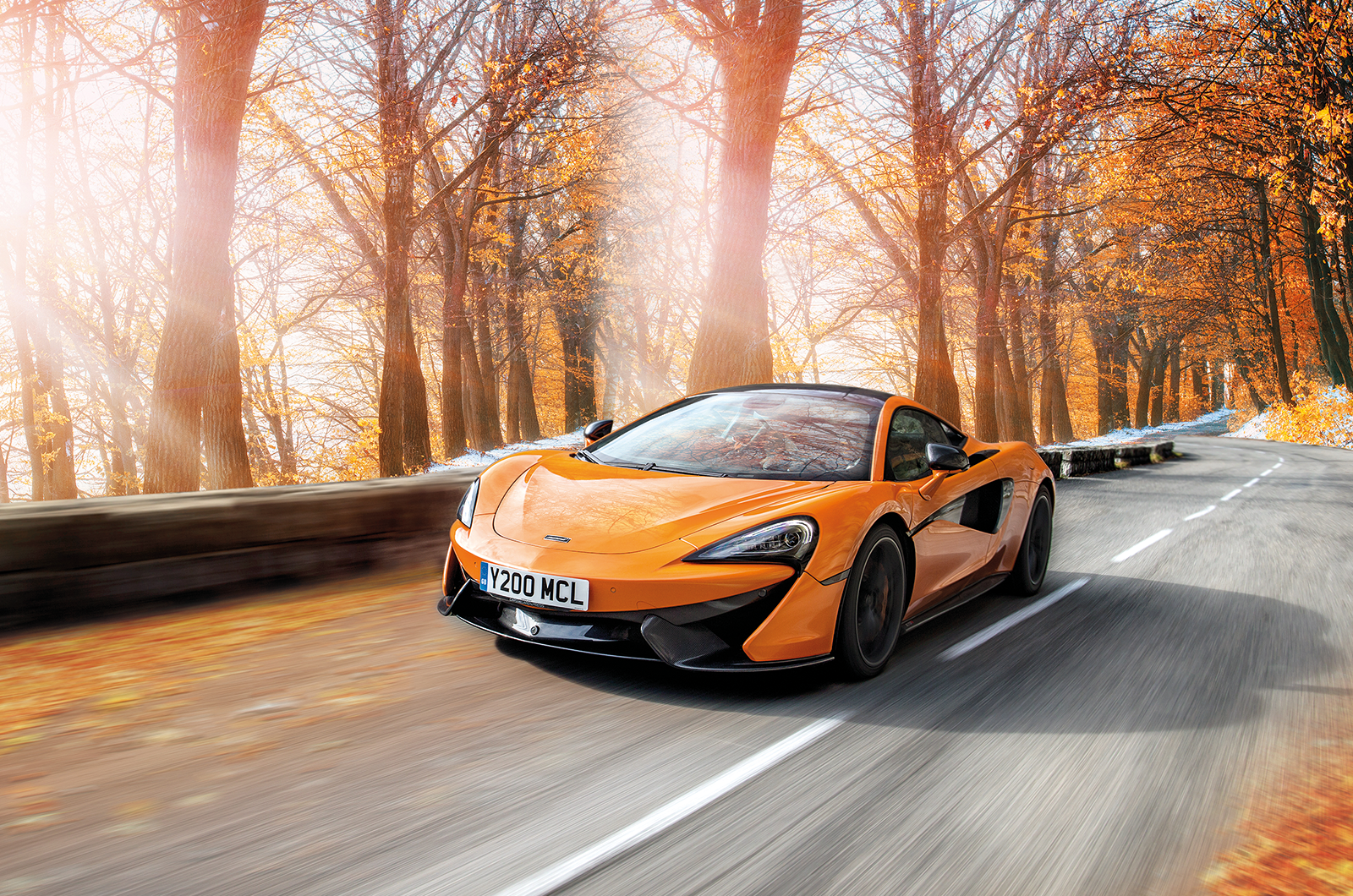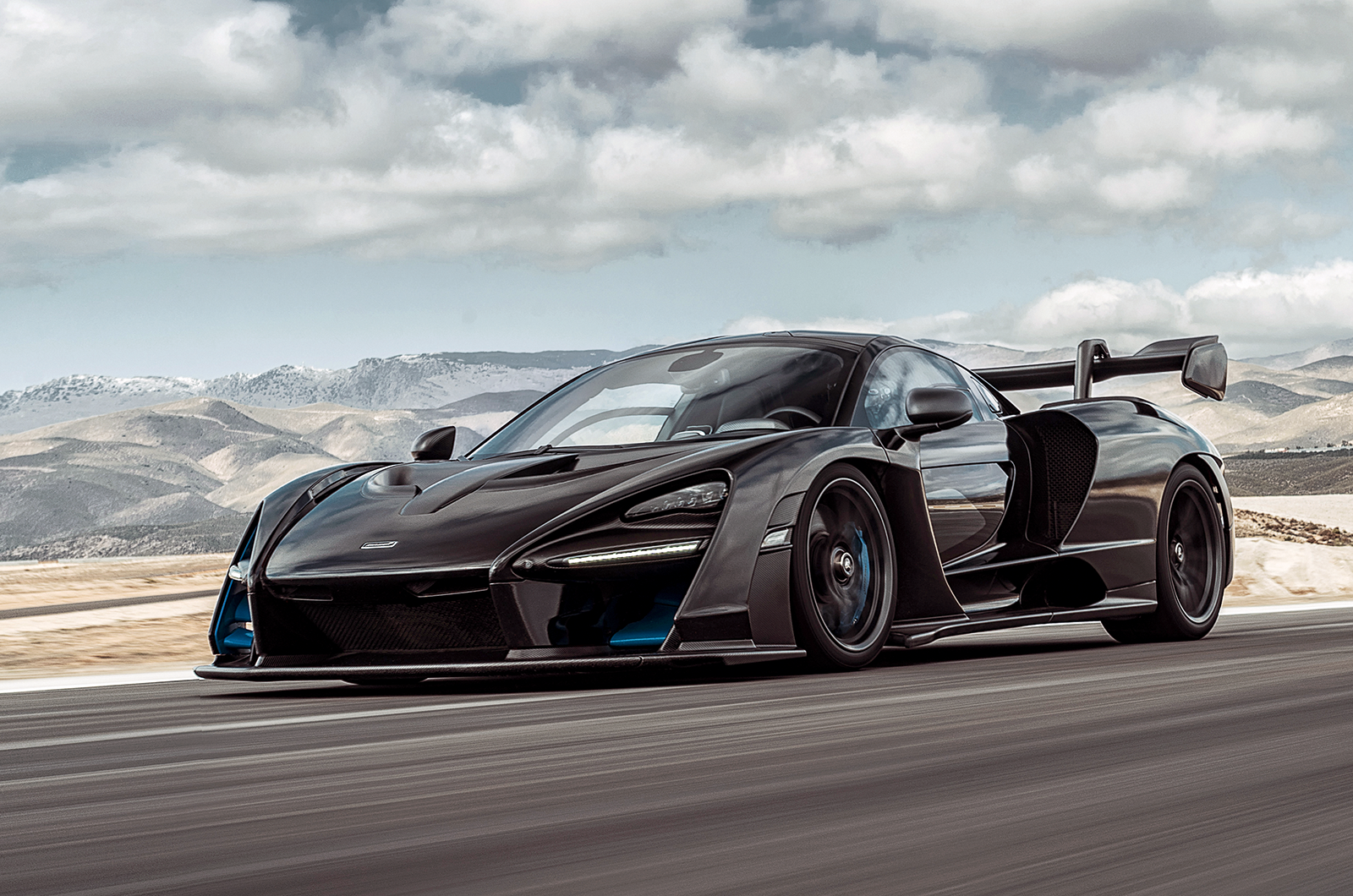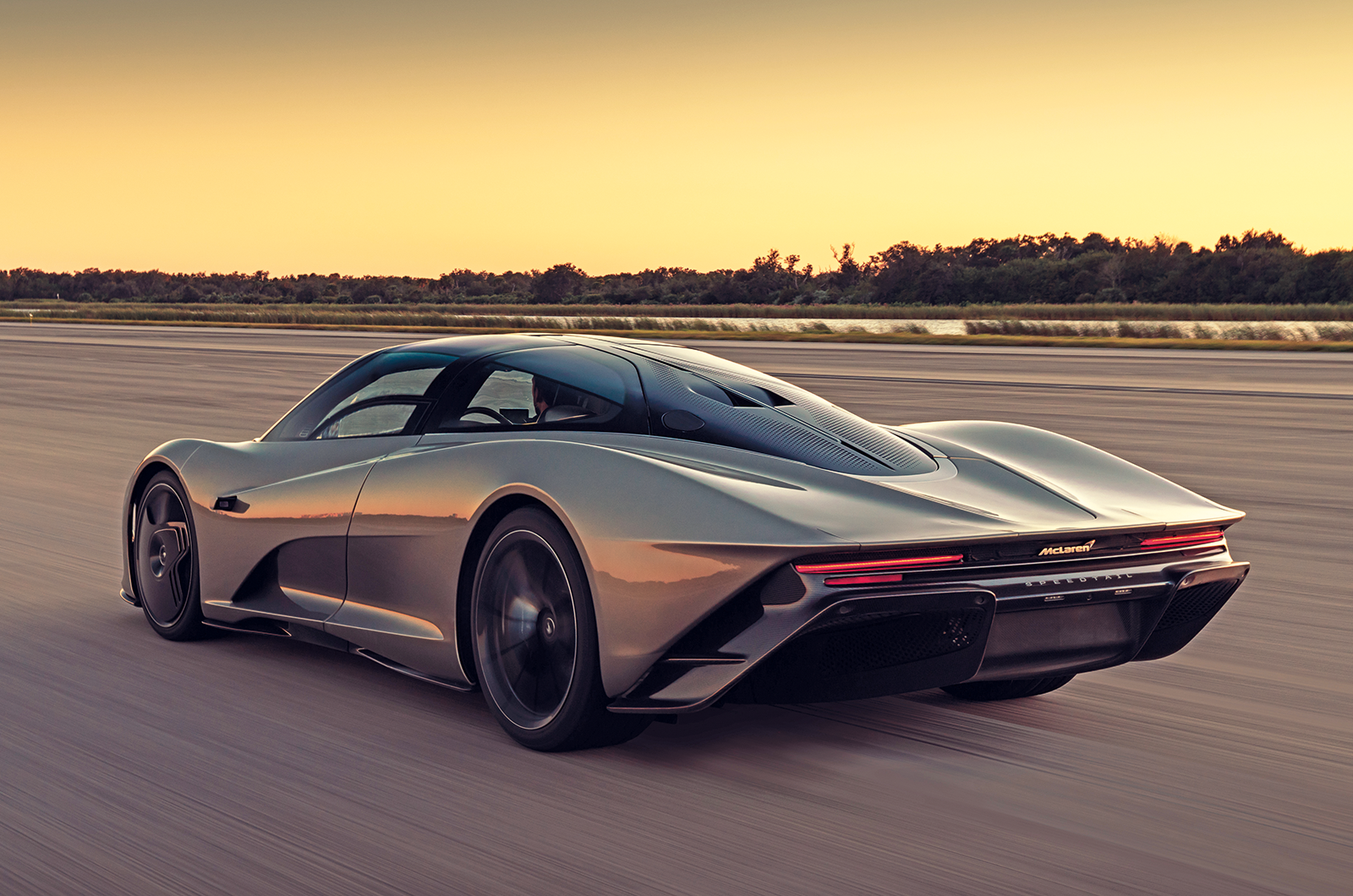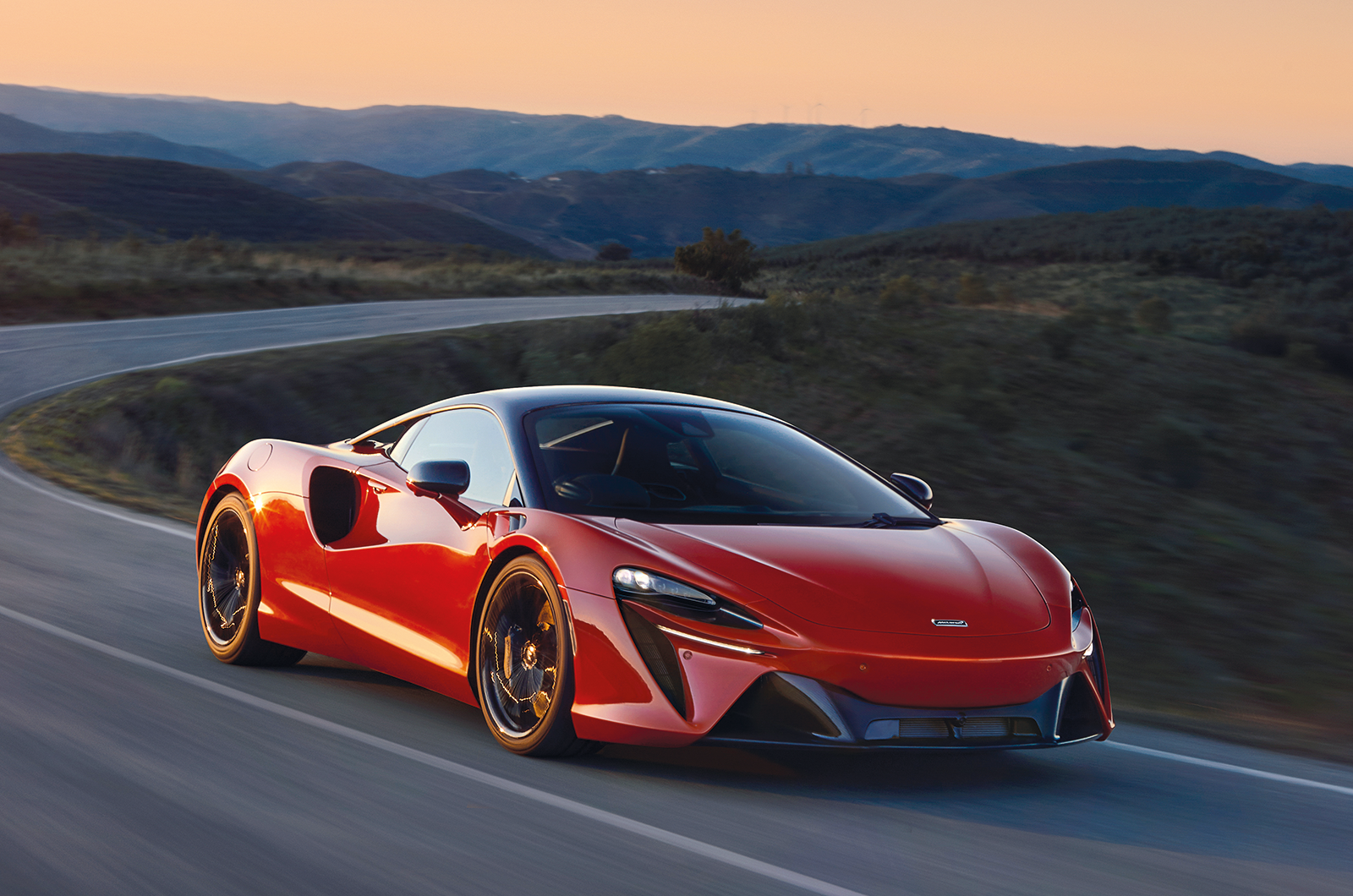The 720S preview was held in a military hangar some 70 miles north of McLaren’s headquarters, with Dennis long since gone.
When former chief test driver Chris Goodwin roared out of the darkness, lapping assembled journalists like a shark circling a diving cage, the overriding impression was of how low the 720S looked, particularly because the engine behind the driver was so low down and tightly packaged – it had been dropped by 150mm, thanks to some reworking of the inlet plenums.
The 720S is also a more dramatic and theatrical design, this time by Rob Melville, a stylist who is obsessed by shrink-wrapping his designs around mechanical skeletons, with references to military aircraft, sci-fi, and nature’s most athletic and fearsome species.
Like the 12C, its 720S successor has high-set exhaust pipes
Even with familiarisation it’s still fascinating to pore over the 720S today and understand its details up close: the ‘eye sockets’ for headlights to generate more cooling; the apparent absence of side air intakes that makes the midriff appear dominated by sinew and muscle (it’s actually a double-skinned door, which allows air to flow through the inner and outer skins); plus the vast slashes in the rear bodywork to aid cooling that give glimpses of the gearbox casing and other mechanical components, like the exposed machine beneath a cyborg’s torn skin.
If the interior lacks some of the flow of a 12C (particularly in its blockier centre console and less attractively profiled instrument binnacle), there are still echoes of its predecessor in the flat-bottomed steering wheel, the low-set driving position, and pedals that are offset to the left.
The cabin is also more user-friendly and of higher quality – the gear-selector switches, the greatly improved infotainment system and more substantial controls for McLaren’s (still clunky) interface for tweaking powertrain and chassis modes being cases in point.
It is evolution rather than revolution for the interior of the 720S
Before we had seen the car on its preview, McLaren’s then product development director Mark Vinnels asked me to guess at how much power the car had.
I estimated 680-700bhp, enough to move the game on beyond the 675 LT and avoid any naming confusion, and to give the 661bhp Ferrari 488GTB something to sweat about.
Then the new car appeared with a display numberplate that read ‘720S’ and Vinnels grinned.
Not only did it have 720PS (710bhp), it was also lighter again than the 650S, reduced by 18kg to a lightest dry weight of 1283kg.
720S leads MP4-12C on track
The figures remain astonishing: 568lb ft of torque, 0-62mph in a blistering 2.9 secs, 0-124mph in 7.8 secs, and 213mph. Only now has the Ferrari F8 matched them, almost identically so.
This car is McLaren finding its mojo – still serious and mechanical in feel, but now with as much an eye on entertainment as metrics.
The handling is more playful and intuitive than a 12C. You notice this even driving moderately hard into a roundabout and backing off – it’s in the way the front bites and the back begins to benignly pivot round it.
‘This car is McLaren finding its mojo – still serious and mechanical in feel, but now with as much an eye on entertainment as metrics’
Amplify all of that on a track and the 720S becomes sensational, feeling both keen to oversteer if you go in late on the brakes, but also incredibly stable and controlled when it does so, simply waiting for throttle instructions as you sit in the cockpit goggle-eyed – though I definitely found it more of a handful than the more locked-down Senna when I drove the two back-to-back at Silverstone.
At the time Goodwin summed it up like this: “There’s a commonality of character with the latter stages of our product line-up, especially the P1 and 570S.
“The direct turn-in, that you can trail-brake into a corner, the lateral support you get when you load the car up into the apex, the nice, supported breakaway.
“In that way the 720S is an evolution, but it’s a revolution in terms of actual performance.”
Incremental developments have seen the 720S move the game on from the MP4-12C
Goodwin went on to say that the increase in horsepower didn’t seem a massive deal to him, but it was the delivery and how the torque came in that made it feel a massive leap.
The sound is comparably gruff to the 12C, there is still lag to around 3000rpm despite new and faster-reacting titanium-aluminide turbine blades for the turbos, but the response on boost feels sweeter and more progressive.
There’s a chunk more performance throughout the rev range, which gives the same-sized rubber even more to deal with, and the final kick beyond 7500rpm is just insane in its force and fury.
Combine that with far more incisive gearshifts and there’s no question that Ferrari has a true fight on its hands with this car. It’s sensational.
The nomenclature has simplified in the past decade
More than anything, it’s the expertise with which this whole package is woven together and deftly calibrated that puts a real gulf between the 720S and 12C, even if the earlier car remains proof that 617bhp is an obscene amount of power, and it has the better, less isolated steering feel.
A decade on since the launch of the MP4-12C, McLaren is at last moving beyond its first car’s blueprint with the Artura, which is built around a new carbonfibre architecture and a hybridised and turbocharged V6 engine
A replacement for the 720S will follow, and to be honest it’s hard to comprehend how ferociously capable that car might well be.
‘It’s the expertise with which this whole package is woven together and deftly calibrated that puts a real gulf between the 720S and 12C’
What we do know is that by 2025 McLaren plans to use 100% hybrid technology, wants to win the supercar ‘weight race’ in the face of electrification, and to offer more than 30 mins of electric-only range on the track.
If all goes to plan, it will be selling 6000 cars per annum.
It’s all a long way from the first ever MP4-12C that set out to give Ferrari a bloody nose.
Given how far McLaren has come in such a short time, however, you wouldn’t bet against it achieving those goals across the next decade.
Images: Stan Papior
Standing on the shoulders of giants
Two M6GTs were converted from racers, while Bruce McLaren’s prototype was built from the ground up
The MP4-12C ignited McLaren’s production ambitions, but the project owed everything to two legendary road cars that came before it: the groundbreaking 1995 F1 and the machine that started it all, the 1969 M6GT.
A change in homologation rules demanding that a total of 50 road cars be built put paid to the project, but Bruce McLaren continued to run one of three prototypes as a road car until his tragic accident at Goodwood in 1970. It’s thought he drove to the Chichester circuit in OBH 500H on the morning of the fatal crash.
As a constructor, McLaren’s greatest early successes came in the musclebound Can-Am series.
The F1 was McLaren’s ultimate driving machine © Tony Baker
The team walked the championship in both 1967 and ’68, and a year later swept to victory in all 11 races with the fearsome M6B, closing out the top three places in two of those with Bruce McLaren himself, Denny Hulme and Mark Donohue behind the wheel.
McLaren’s next target was endurance racing success, and to homologate the M6B for use in the World Sportscar Championship a fabulous prototype was built.
Low, light and blisteringly quick, the M6GT was powered by a Bartz-tuned 350cu in Chevrolet V8 that could propel the svelte supercar to 100mph in just eight seconds, and on to a top speed in excess of 165mph.
The central driving position (left) and gold heat-shielding were among the quirks of the no-compromise F1 © Tony Baker
The spirit of the M6GT lived on in the technologically advanced F1, when designer Gordon Murray proposed his concept of the ultimate driving machine to McLaren boss Ron Dennis.
The car that followed stayed true to the principles of light weight, high power and race-derived technologies that marked out the M6GT.
One of the first production cars to use a carbonfibre monocoque chassis, the F1 weighed just 1138kg yet boasted 618bhp from its 6064cc BMW V12 powerplant – good enough, when combined with its slippery Peter Stevens-penned bodywork, to make the 240mph McLaren the fastest car in the world.
McLaren Automotive’s motoring milestones
- 2010 Ramp-up begins for the McLaren Automotive era: £40m invested in the McLaren Production Centre, where up to 1000 cars can be handbuilt annually; 300 additional staff recruited, taking the total to around 1000
- 2011 The first production MP4-12C is completed
- 2012 P1 previewed, starting the Ultimate Series line. The second car of the new era is a limited-edition hybrid hypercar good for 903bhp and able to run on electric power alone
- 2013 Managing director Antony Sheriff departs (and takes McLaren to court), replaced by COO Mike Flewitt. First year in the black: 1395 cars delivered, £12.4m operating profit
From top left: the P1 was previewed in 2012; when the 12C was facelifted it became the 650S; Ron Dennis was ousted in 2016
- 2014 650S launched as a facelifted 12C, addressing various issues with the original car. McLaren Automotive increases headcount to 1283, 25% more than 2013, and posts a £20.8m operating profit, £15m profit before tax
- 2015 570S revealed, introducing the Sports Series line. More than 5000 cars have now been produced in total
- 2016 Track22 business plan announced, pledging £1bn investment in R&D over six years and 15 all-new cars. Fully electric Ultimate Series model evaluated. 3286 cars sold. Ron Dennis forced out by fellow shareholders
- 2017 McLaren announces the new McLaren Composites Technology Centre, based near Rotherham, with £50m investment, 220 new jobs. 720S revealed, replacing the 650S. Rob Melville replaces Frank Stephenson as design director. Ron Dennis sells all shares. 3340 cars sold
Clockwise from top left: the Sports Series line started with the 570S; the evocative Senna; Artura is McLaren’s second hybrid; just 106 Speedtails in total
- 2018 Kenny Brack replaces Chris Goodwin as chief test driver, as the latter leaves to head up mid-engined Aston Martin development. 15,000 cars have now been produced in total. Senna hypercar joins Ultimate Series
- 2019 Speedtail revealed in the Ultimate Series, with its three-seater layout and production run of just 106 cars underlining its billing as the F1’s successor. At the other end of the spectrum, the new McLaren GT offers buyers a more comfort-orientated gran turismo model
- 2020 Production temporarily halted in March due to COVID-19. Ultimate Series Elva roadster launched
- 2021 Production due to commence of the Artura, McLaren’s second hybrid model and its first with a V6 engine
READ MORE
Double centurions: Mercedes-Benz SLR McLaren vs Bristol Fighter
Future classic: McLaren 600LT
$15m unique McLaren F1 heads to auction
Ben Barry
Ben Barry is a contributor to Classic & Sports Car
